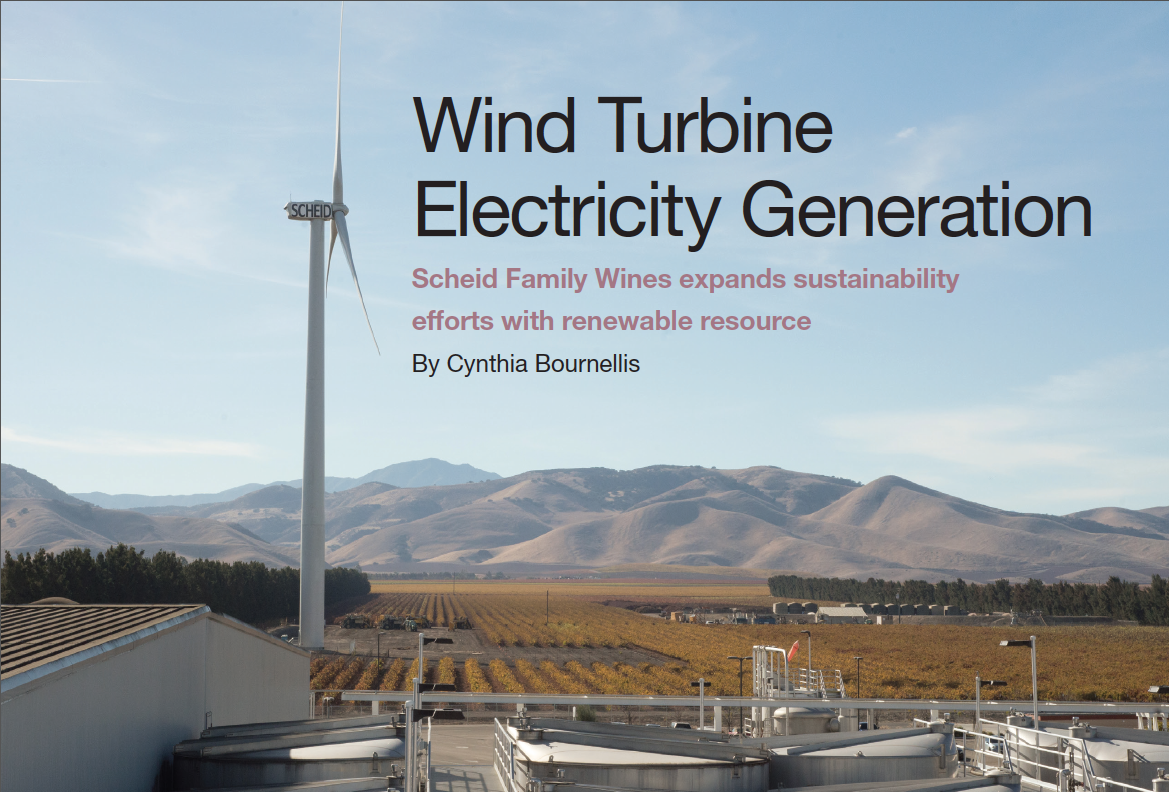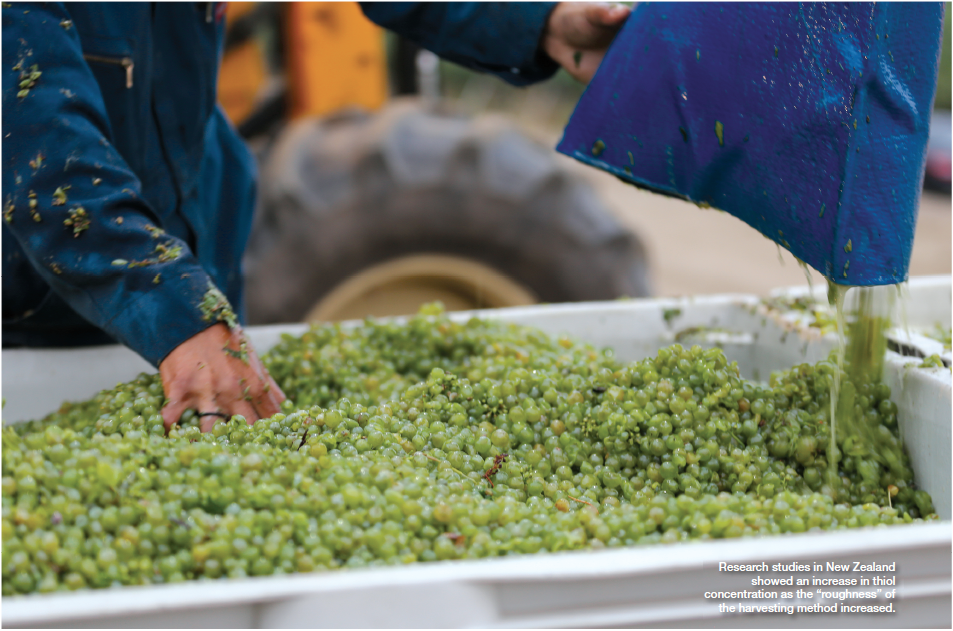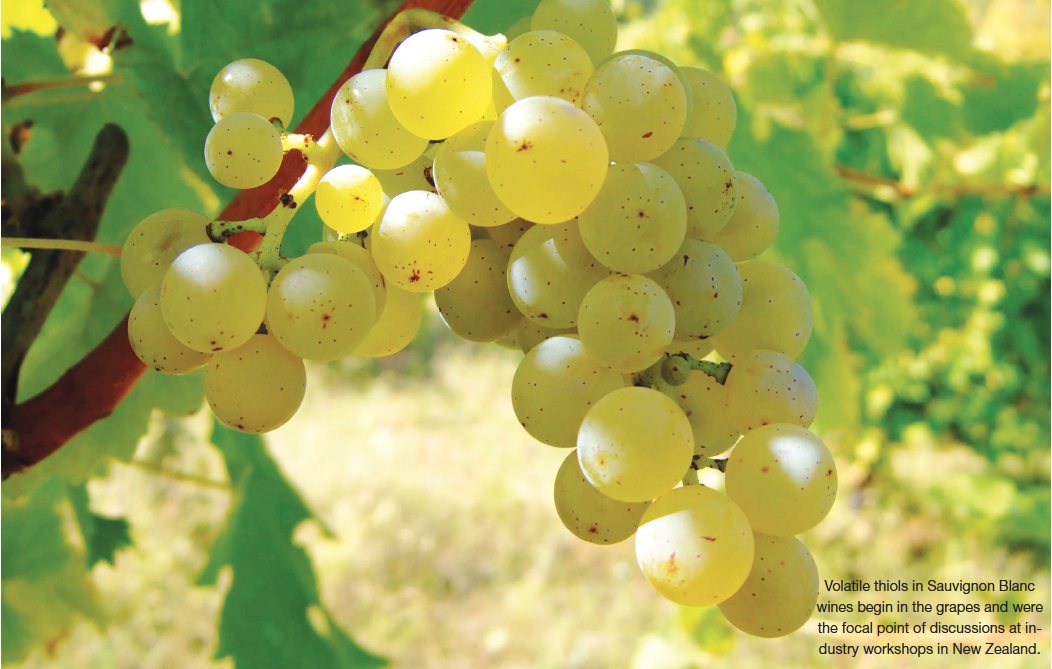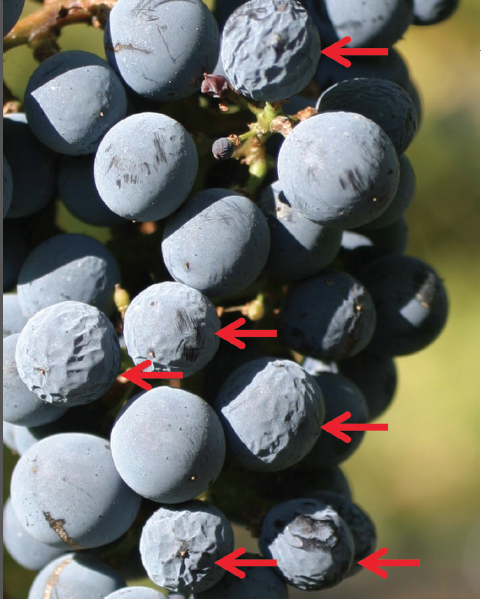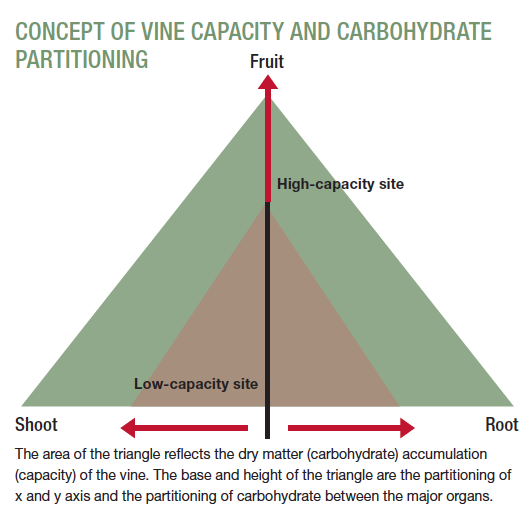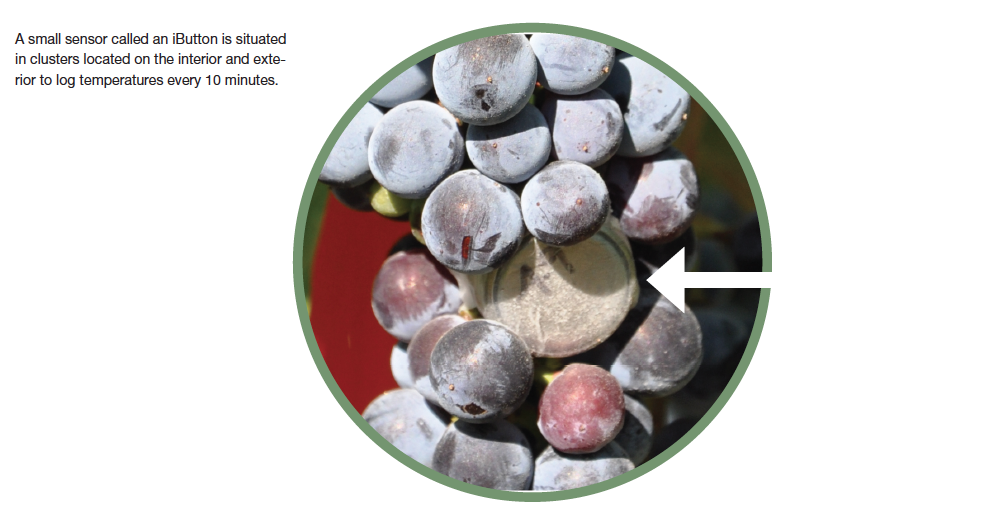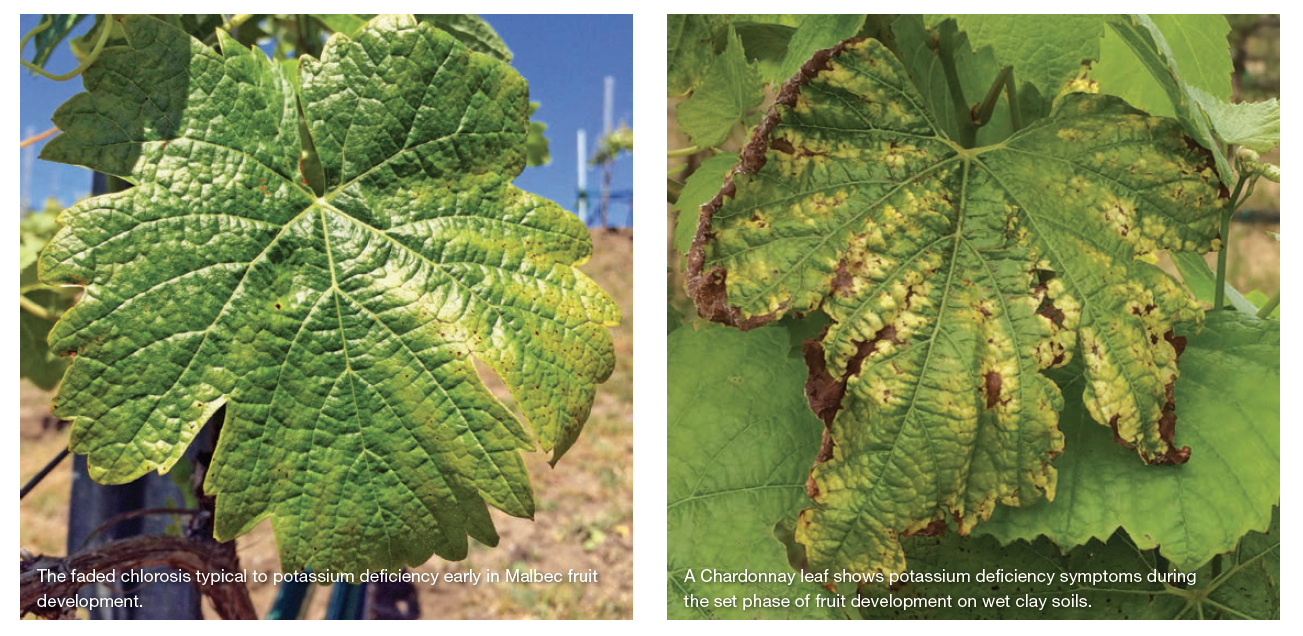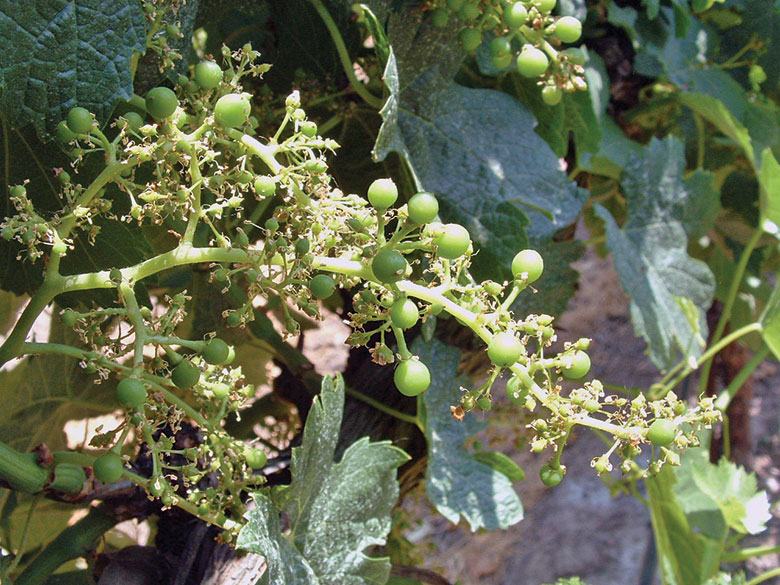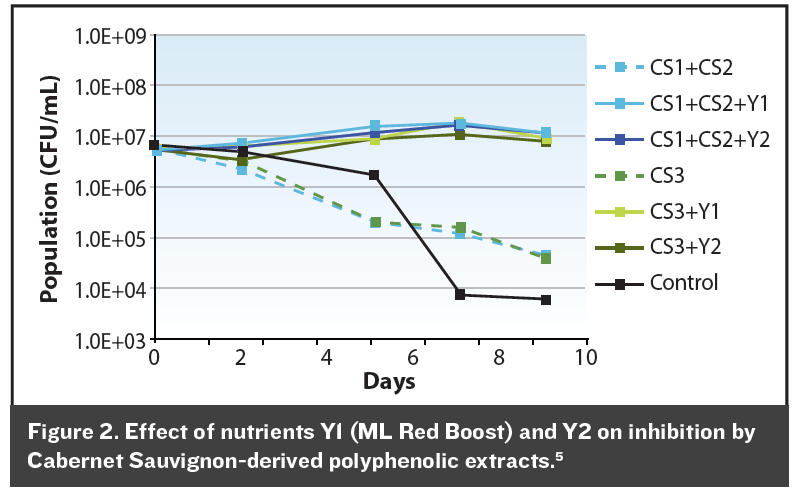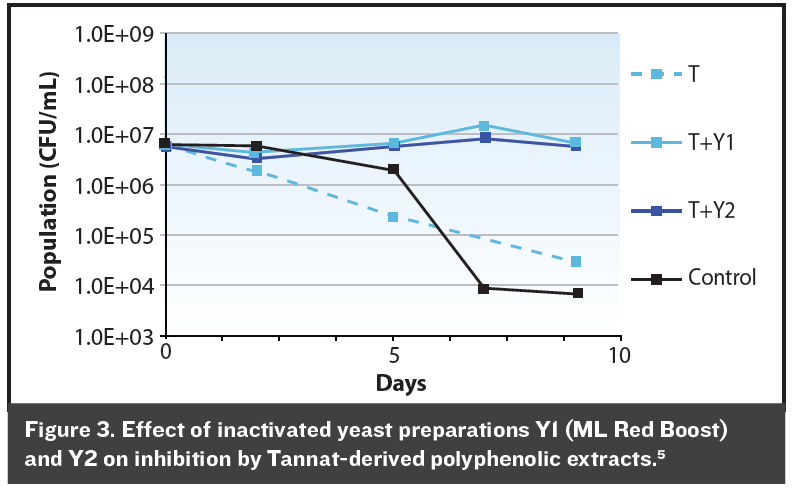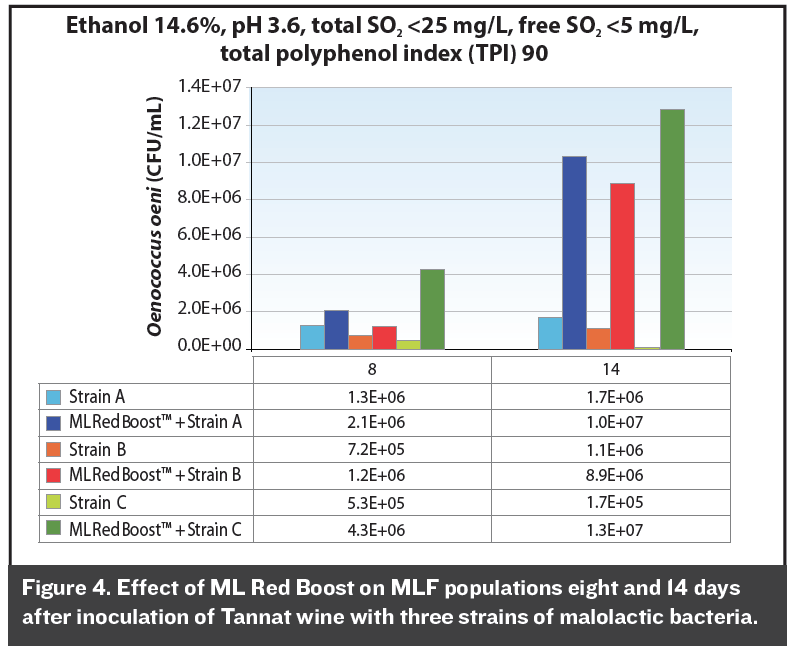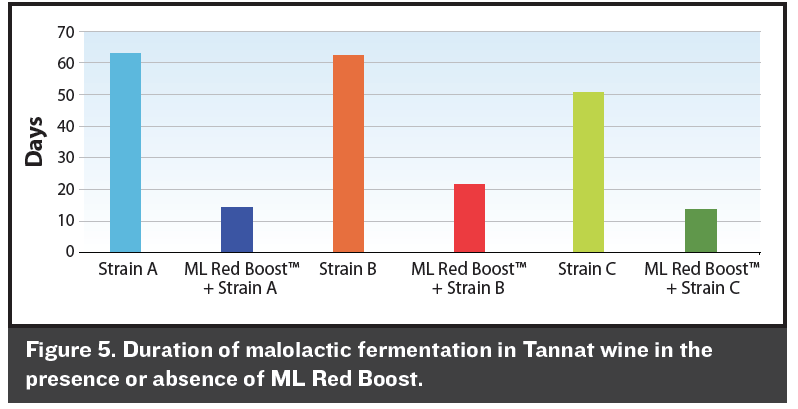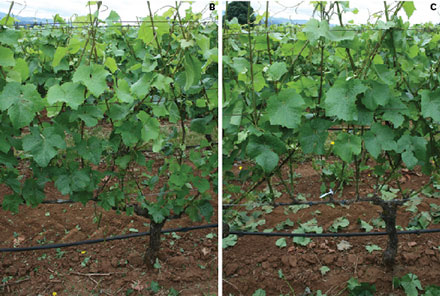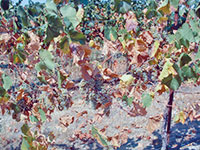
Practical Winery & Vineyard
by Stacey MoskwaPractical Winery & Vineyard
November 2018Upgrading Traditional Lab Analysis
Part one: Quality systems in the winery lab
READ MORE »
Practical Winery & Vineyard
November 2018Sulfur Dioxide Measurements in the Winery
Winemakers routinely add sulfur dioxide (SO2) to wines to prevent microbial and oxidative spoilage. In red wines, a large portion of SO2 is bound to anthocyanins (red pigments). Standard approaches to measuring SO2 in wines involve an initial acidification step that releases this anthocyanin-bound SO2, but it was unknown if this affected the precision of SO2 measurements for the purposes of predicting microbial stability. Some authors have proposed that anthocyanin-bound SO2 is also antimicrobial, but this work refutes that claim and shows that standard approaches do not accurately describe the antimicrobial activity of SO2 in red wines.
READ MORE »
Practical Winery & Vineyard
October 2018Improving Red Wine Color and Mouthfeel Over Time
Formation of polymeric pigments is important for successful cellaring of red wine as they help soften wine’s astringency and provide long-lasting color. Research supported by the Washington State Wine Commission has identified factors that can maximize polymeric-pigment formation to help improve red-wine quality.
READ MORE »
Practical Winery & Vineyard
September 2018Wind Turbine Electricity Generation
Wind is not just something that you can feel against your skin, hear when it howls, or see the effects of its devastation. Wind also is one of the fastest-growing sources of electricity in the world. In the United States, wind energy ranks fourth in electricity production, behind natural gas, coal and nuclear energy, according to the California Energy Commission (CEC).
READ MORE »
Practical Winery & Vineyard
August 2018Winemaking in the Era of Climate Change
An increase in average temperatures in recent years is profoundly changing climatic parameters that influence agricultural activities, including rainfall patterns, maximum and minimum temperatures and humidity.
READ MORE »
Practical Winery & Vineyard
July 2018Growing a Revolution
For much of human history, the role of organic matter in soil fertility was no secret. Farmers and philosophers alike believed that humus - soil organic matter - nourished plants. Until, that is, two key discoveries undercut this long-held belief. The first was the discovery of photosynthesis - that plants obtained their carbon, and thus most of their mass, from the air and not the soil. The second was the observation that most humus was insoluble and could not be sucked up by plant roots. So soil organic matter did not feed plants.
READ MORE »
Practical Winery & Vineyard
June 2018Enzyme and Tannin Applications
Enological tannins and enzymes are powerful winemaking tools. Proper use can improve the basic characteristics of a wine, from increasing the depth of color to imparting fuller and more supple tannins to the final wine. Other, subtler process improvements include better filtration, protection from oxidation and microbial control.
Enological enzymes
READ MORE »
Practical Winery & Vineyard
June 2018New Tools to Limit Wine Spoilage
Once Brettanomyces bruxellensis takes hold in a winery, eradication is formidable, often requiring more than one approach to keep the wine-spoilage yeast at bay. Recent findings by Washington State University show that the interaction between storage temperature and alcohol concentration may be a useful tool to manage Brettanomyces.
READ MORE »
Practical Winery & Vineyard
May 2018Preserving and Increasing Thiols
New Zealand winegrowers use mechanical harvesting as a norm. This is probably out of necessity, however it is by far the harvesting method delivering the highest concentration of thiols. This is contradictory to what has been believed for years to be best practice when producing top quality wines.
READ MORE »
Practical Winery & Vineyard
April 2018Managing Green Flavors in the Winery
Green, vegetal flavors in wine are typically associated with fruit that has not achieved the desired level of ripeness. Often such wines suffer from other quality issues linked to grape immaturity, including high acidity, poor color and lack of varietal aroma. Thus, green flavors in wine are almost universally rejected by consumers. The exceptions are when these notes can be considered (at low levels) part of the expected varietal character, such as in cool-climate Cabernet Sauvignon, Carménère and Sauvignon Blanc.
READ MORE »
Practical Winery & Vineyard
April 2018Grape-Derived Fruity Volatile Thiols
Sulfur-containing compounds in wine include a wide range of typically very powerful aromatic molecules. These compounds are referred to as mercaptans or volatile thiols, both indicating compounds containing the sulfhydryl group (-SH). Wine industry and research circles have grown accustomed to some of these generic terms being used for specific compounds.
READ MORE »
Practical Winery & Vineyard
March 2018Grapes and Irrigation Myths Debunked
Essential in arid and semiarid grapegrowing regions, irrigation is a management tool used to manipulate yield and enhance the quality of wine grapes.4 However, longstanding myths of the wine industry still have strong influence on irrigation practices—to the detriment of vine health and the wine grape grower’s pocketbook.
READ MORE »
Practical Winery & Vineyard
February 2018Smoke Taint in Wine
READ MORE »
Practical Winery & Vineyard
August 2017Understanding Terroir Expression
Terroir is a cultivated ecosystem in which grapevines interact with soil and climate. The main climatic parameters include temperature, rainfall and reference evapotranspiration. Vine phenology and grape ripening is mainly driven by air temperature and soil temperature. The soil provides water and minerals to the vine, particularly nitrogen.
In the past several decades, tools have been developed to quantify terroir parameters. Small-scale weather stations can yield temperature data at high resolution, which can be used to provide refined maps of temperature summations. Models have been developed to predict phenology in relation to temperature. Vine water status can be assessed with a pressure chamber, or by means of carbon isotope discrimination measuring grape sugar (so-called δ13C).12 Vine nitrogen status can be assessed with measurement of yeast assimilable nitrogen (YAN). In this way, terroir parameters can not only be measured but also mapped.
This approach allows precise vineyard management to optimize terroir expression through plot selection, choice of appropriate plant material in relation to soil and climate, vineyard floor management, fertilization and training system.
Defining terroir
READ MORE »
Practical Winery & Vineyard
July 2017Uninoculated Fermentation
Interest in uninoculated primary fermentation is increasing in wineries around the globe. This trend has various drivers including consumer preference for a perceived “natural” product and quality considerations. The latter motivation is likely the most significant, as research from institutions around the world highlights the potential positive impacts of vineyard- and winery-associated non-Saccharomyces yeasts (or wild yeasts) on the flavor, aroma and perceived complexity of the wines produced.
Research at the Institute for Wine Biotechnology at Stellenbosch University, South Africa, has demonstrated the ability of several non-Saccharomyces yeasts isolated from a local vineyard to reduce wine ethanol levels by up to 1.5% and produce higher concentrations of desirable aromatics such as esters and monoterpenes.1
One important concept is that of “microbial terroir,” a term now fully entrenched in the wine dictionary. Until fairly recently, the potential contribution of microbes such as yeast and bacteria to terroir had been ignored.2
Recent studies (mostly in the past five years) have revealed that microbial populations contribute to the perceived geographic character and sensorial signatures of wines produced by fermentation with native-selection yeasts.3,4,5 Spontaneous fermentations are thus an ideal means to exploit the natural microbial biodiversity (unique in many ways) and enhance the regional identity of wines.6
There is a reason why yeast inoculation from dry active cultures of S. cerevisiae revolutionized winemaking in the first place: The risks associated with spoilage and stuck or sluggish fermentation in a spontaneous fermentation made controlled inoculation an attractive option for winemakers in the past. Fortunately, our understanding of non-Saccharomyces yeasts and ability to monitor and control fermentations have improved significantly over the years, affording today’s winemakers the best of both worlds: a predictable and successful fermentation outcome combined with the sensory complexity associated with spontaneous fermentation.
For winemakers considering a first foray into spontaneous fermentation, here are some helpful hints to guide you on your journey.
Quality is key
READ MORE »
Practical Winery & Vineyard
June 2017Grapevine Triangle
Commercial grapegrowers strive to produce the maximum profitable yield of grapes at the composition required to produce wine of a target style that meets quality expectations of consumers. However, this must be done consistently. Since grapevines are perennial plants, the yield must be achieved without negatively influencing the vine’s capability of producing a crop in subsequent years. To achieve the correct balance between fruit yield and root and shoot growth, viticulturists need to enable the current season’s crop to ripen without “stealing” from vine reserves and negatively affecting next year’s crop.
When contemplating vine balance, the factors that determine the capacity of the vine to fix carbohydrates (sugars) through the process of photosynthesis and to accumulate inorganic nutrients for growth need to be considered.
The rate of photosynthesis and the ability of vines to fix carbohydrates largely reflects the environment in which the vine is growing (warmer sites with increased sunlight and a longer growing season will generally have greater capacity to accumulate carbohydrates). However, vine photosynthesis can be manipulated by growers with the selection of vine-training systems, vineyard design and spacing.
For example, the development of divided canopy-training systems has been shown to simultaneously increase potential yield and improve fruit composition.24 The systems increase the intercepted solar energy and enhance the ability of vines to fix photosynthates, thereby increasing their capacity.
At the leaf level, light saturation (the point at which increasing light intensity does not further increase the rate of photosynthesis) reaches its maximum at about 1,000 µmol m-2 s-1.14 However, in the field, higher light intensities may continue to increase the rate of vine photosynthesis as light penetrates farther into the canopy, increasing the photosynthetic rate of leaves underneath the outer layer of leaves.22
In addition to site effects, the available energy changes both between and within a growing season. Early in the season, temperatures are generally lower than mid-season, and day length is shorter. At the same time, the canopy is still developing. Early, rapid shoot and leaf development at this time often reflects the carbohydrate and nutrient reserves accumulated in the trunk and root system the previous year. Similar incoming energy reductions are observed in the autumn, although by this time, the canopy should be full size.
Fixed photosynthates now are accumulated in the fruit as it ripens. However, to ensure adequate over-wintering, reserves of carbohydrates and nutrients have to build in the roots and trunk at the same time. In many cool climates, leaf senescence coincides with harvest, thus it is important to build up reserves in the trunk and roots by this time.1 In warmer climates, where leaves remain functional post-harvest, the reserves can accumulate during this period. For this reason, the timing of leaf senescence in relation to the date of harvest is a key difference between warm and cool-climate viticulture.
While this review largely considers the role of photosynthates in vine balance, other environmental and biotic factors must be well managed. The professional grower must minimize damage to vines caused by pests and diseases, waterlogging, frost etc. While inadequate inorganic nutrition (nitrogen) and/or water stress will slow growth, excessive water stress will slow photosynthesis. A degree of mild water stress and a slowing of growth may be an advantage by redirecting photosynthates from vegetative growth to fruit development later in the growing season.
Additional aspects in determining vine balance include the mechanisms that control the distribution of photosynthates to the different sinks (predominantly shoots, roots and fruit, etc.) within the vine.
Distribution of the sugars from sources (generally the leaves, except in early spring when remobilization from overwintering reserves are the predominant source) depends on the demand from various sinks in the vine. Photosynthates are conducted to the various sinks through phloem vessels.
READ MORE »
Practical Winery & Vineyard
June 2017Deficit Irrigation
It's often thought that if some is good, more must be better. But that axiom does not apply to regulated deficit irrigation, according to research conducted by Washington State University (WSU) scientists. Regulated deficit irrigation is a management strategy used by grapegrowers to fine-tune canopy development and improve fruit-quality attributes.1
"Though some water stress can often help improve wine grape quality, there is such a thing as not providing enough water for the vine," says Dr. Markus Keller, lead investigator of regulated deficit irrigation research supported by the Washington State Wine Commission, a state agency representing all wine grape growers and wineries. Keller, a horticulturist at WSU's Irrigated Agriculture Research & Extension Center in Prosser, specializes in vine physiology, irrigation and cold hardiness and is author of The Science of Grapevines: Anatomy and Physiology.
The research by Keller et al. could help wine grape growers save up to 30% of the water used to irrigate grapevines and save energy costs to pump the water without sacrificing grape yields and quality. Throughout the world, water availability is a growing problem due to a changing climate. During the 2015 drought in Washington state, water was rationed in prime irrigated acreage in the Yakima Valley, where high-value crops such as apples, grapes and hops are grown.2
The WSU study showed that regulated deficit irrigation (hereafter referred to as deficit irrigation), while generally beneficial, can be taken to extremes and go too low. Vines receiving only 25% of crop evapotranspiration (ETc) in the study were economically unsustainable due to reduced yields and vine decline compared to other treatments in the trial.
Earlier research has suggested that relatively severe deficit irrigation can achieve significant water savings compared to moderate deficit irrigation and can have additional effects on vine performance.3,4 But that research raised two questions: 1) How severe is too severe? 2) Can water be saved and grape quality improved without sacrificing long-term vine productivity?
The impact of increased water supply during ripening and its relationship to alleviating drought-induced berry shrinkage was examined because little research in this area has been conducted in the field. Recommendations in the "Guidelines for Integrated Production of Grapes" from the International Organization for Biological and Integrated Control declare that irrigation of vines for wine production must not be applied after véraison (or is highly restricted) to guarantee "good wine."5
But withholding water after véraison is at odds with recommendations to avoid inappropriate water stress during ripening.6 Some studies have suggested that late-season irrigation may help alleviate drought-induced berry shrinkage and does not increase berry size.7
Deficit irrigation regimes
READ MORE »
Practical Winery & Vineyard
April 2017Sweet Triterpenoids in Oak for Cooperage
Oak aging is a crucial step in winemaking, during which the organoleptic properties of wine are modified. Various parameters affect the chemical composition of oak, and botanical origin previously has been shown to be a determinant factor.Source: Seguin MoreauREAD MORE »
Practical Winery & Vineyard
March 2017Mineral Character in Wine
What is minerality in wine? What are we experiencing when we label wine attributes as “mineral?”
Despite frequent current usage, the term mineral as a wine descriptor reflects a relatively recent fashion, for which the term appears to have no clear definition.1,2 When white wines are described sensorially in terms of mineral characteristics, the attributes employed are multi-dimensional, meaning they involve smells, tastes and tactile sensations. Further, they range from stone and soil-related terms (e.g., flinty; wet stones), seashore terms (e.g., iodine and seashell), smoky and gunflint notes, tastes of acidity, bitterness and saltiness, to the kerosene-like notes in Rieslings.2
The sole clear and consistent aspect is that perceived minerality in a wine appears favorable in terms of wine marketing, with perceived minerality linked to higher priced wines. Conceivably this is because wine characteristics interpreted by tasters as mineral (such as flinty, chalky or oyster shell) have an ability to evoke wider concepts via associative memory including the powerful marketing tool of vineyard location, or terroir.1,2
However, with many viticulturists and more recently geologists including Alex Maltman3 arguing that we cannot literally be smelling or tasting the vineyard rocks and soils, the question arises: What are we experiencing that induces us to use terms pertaining to rocks and soil when describing attributes of a wine?
Maltman, a professor of earth sciences at Aberystwyth University in Wales, outlined in a recent talk9 at the Institute of Masters of Wine in London, UK, the disconnect between geological minerals (elements) and the 14 mineral nutrients required by vines, pointing out that “these 14 are not the same minerals as geological minerals.”
“Elements are not necessarily bioavailable.…Weathering processes are too slow to keep pace releasing nutrients for vegetation year after year, (and) the cycle is interrupted with agriculture. Nutrients are removed each year in crops, so we have to add compost, fertilizer.…Most of the nutrients are coming from humans, not the geology,” he explained.
Added to the conundrum is that minerals do not vaporize. They are odorless, and their concentration in wine is far below the taste threshold. This latter point, however, must be qualified in that sub-threshold tastes and smells have been demonstrated to interact to produce an experience of “flavor.”4
Is minerality in wine all in the mind?
READ MORE »
Practical Winery & Vineyard
February 2017Impact of Oak Tannin on Red Wines
For many years, the cooperage industry developed tools to select and classify oak with the goal of ensuring quality, precision and reproducibility in their barrels. Selection on the basis of geographic origin dates back to the early 19th century.1,2
Selection according to morphological criteria such as the width of growth rings (grain), closely linked to forestry management methods and botanical species, was first applied about 50 years ago.3,4,5,6 In recent years, the market for fine-grain oak has grown dramatically. Some forests are so sought after that sourcing has become difficult, which in the long term could lead to the total depletion of large-diameter (60-80 cm) fine-grain wood resources.
Recent extensive research in the variability of the chemical composition of oak has highlighted an alternative selection criterion. Indeed, while selection by forest and/or grain is useful for controlling barrel quality, it does not reflect the tremendous variations in composition, both on an inter-7,8,9,10,11,12 and intra-individual level.11,13,14,15
Barrel quality control and reproducibility are key concerns for winemakers, as barrel aging forms an integral part of each wine’s distinctive signature, and the choice of barrels can result in significant changes in a wine’s sensory profile. For example, one experiment on four lots of 10 barrels revealed that a single barrel was capable of inducing a 50% variation in concentrations of major volatile compounds from oak in the final blend.16
Given this new data, the challenge for winemakers is to obtain barrels of known, homogeneous, reproducible quality. Therefore, it is necessary for the cooperages to control the concentration of extractable compounds in oak. In 2009, Groupe Vicard launched a research program aimed at controlling variability factors during barrel making.
This research led to the development of a specific range (Vicard Generation 7) based on wood selected according to its ellagitannin content.12 Ellagitannins represent the majority of extractable compounds and contribute significantly to variations in composition and quality during élevage.17,18,19,20 Analysis using near-infrared spectrometry identified three main classes of tannin potential corresponding to distinct ellagitannin contents in untoasted wood.
This analytical approach to wood selection was accompanied by other innovations aimed at controlling the factors responsible for variability in cooperage: scarification of the staves (blister-free process consisting of micro-slits to allow water locked in the wood to escape naturally during the toasting process), short, automated steam-bending, and a unique process for toasting not previously used in cooperage. Toasting using radiant heat in a fully automated and computer-controlled, closed system guarantees homogeneity, reproducibility and precision.12
This system also makes it possible to adjust toasting according to the tannin level of the oak. Because thermal degradation of ellagitannins varies according to toasting time and temperature,9,21 it is necessary to adapt toasting parameters to different tannin potentials. This is a fundamental aspect of this approach, because without complete control of the toasting process, the upstream classification of oak on the basis of its tannin content would be meaningless.
Combining this new oak selection and classification criterion with the toasting system described above produces barrels with known, homogeneous, reproducible tannin levels and has opened up avenues for further research.
What follows are the results of an experiment made from a single estate in two different vintages, with the objective to study the impact of geographic origin within French oak forests as well as grain width and potential tannin level of oak used in barrel making on the sensory profiles of red wines.
READ MORE »
Practical Winery & Vineyard
February 2017Evidence of Phenological Shoot Autonomy in Grapevines
Phenological development in grapevines has been described as being asynchronous (not occurring at the same time).2,3 Beginning with bud break, there are differences in the date when individual buds on a grapevine begin to swell and open. Likewise, at bloom, cap fall in flower clusters does not always occur at the same time, which, in turn, is related to asynchronous softening and color development during véraison.8 At any time during the growing season, some variability in phenological stage between shoots on the same vine is to be expected and observed (see photo below).2
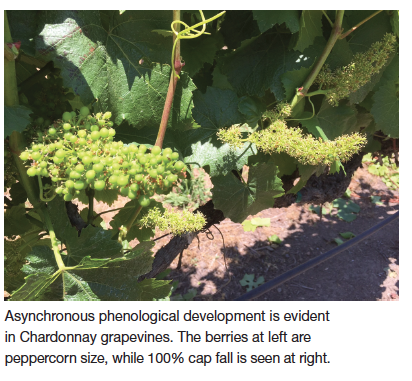 READ MORE »
READ MORE »
Practical Winery & Vineyard
January 2017Industry Leaders Optimistic About Premium Wines
Millennials, whose baby boomer parents were the first generation of premium wine drinkers in the United States, are consuming more and higher value wines, driven by a thirst for quality, new experiences and information-sharing, according to wine industry leaders surveyed by the University of California, Davis.
READ MORE »
Practical Winery & Vineyard
December 2016Oxygen's Impact on Red Wine Aging
High-quality red wines generally require a period of aging in the bottle before they are ready for consumption. During this time, modifications of sensory properties occur such as the decrease of astringency1 and stabilization of color from purple-red to orange-red.
READ MORE »
Practical Winery & Vineyard
November 2016Potassium Accumulation by Grapevines
Potassium (K) is the major cation in ripe grapes, accounting for about 75% of the total mineral cations. Grape juice pH is strongly correlated with grape juice K and largely determines the pH of the wine after fermentation, with high wine pH negatively impacting wine color, stability and taste.18
Adjustment of pH with tartaric acid during vinification is routinely applied to protect against such impacts.5 The aim is generally to bring pH to below 3.0 for white wines and below 3.5 for red wines.8 Rootstocks can lead to differences in K concentrations in grape berries and grape juice,15 which can carry over into wine. Balanced K accumulation by grapevines is important to avoid deficiency (see Malbec and Chardonnay photos above) or excessive uptake. The interrelationships between K and pH in grape juice and wine are discussed below.
Potassium accumulation by grapevines
READ MORE »
Practical Winery & Vineyard
September 2016Balancing Tannin Maturity and Extraction
Wine tannins play a pivotal role in defining wine style because they are directly responsible for sensory aspects such as astringency and bitterness; indirectly, wine tannins and their reaction products (such as polymeric pigments) modulate wine color and astringency.
Seed- and skin-derived tannins differ in their chemical makeup, which affects their sensory properties.
Seed-derived tannins endure a generally bad reputation with winemakers, as seeds are particularly rich in monomeric flavan-3-ols that elicit bitterness, while skin tannins have higher molecular weight but would convey a rounder mouthfeel to a final wine due to their association with polysaccharides and mannoproteins.

In studies conducted with model wines (simple aqueous solutions containing about 13% ethanol by volume and adjusted to pH 3.6), extractability of seed tannin into wine has been shown to decrease as grape maturity progresses.15 As a result, picking decisions based on parameters such as seed color and so-called visual “seed maturity” have been adopted by some winemakers. The rationale is that berries with brown seeds have low extractability of seed tannins and, conversely, higher extractability of skin tannins than berries bearing green seeds.
The need to limit seed tannin extraction into wine by delaying harvest until seeds turn uniformly brown has led to an increase of Brix levels at harvest, and concern exists that higher ethanol levels (EtOH) resulting from a high Brix level in the fruit could also favor seed tannin extraction, thereby counteracting this “late harvest-brown seeds” effect. This is because an increase in EtOH during maceration may selectively promote the extraction of seed tannins due to the dissolutive effect of EtOH on the fatty outer coat of the seeds.
If fruit maturity is assumed as a factor determining the proportion of seed- and skin-derived tannins in the finished wines, it is logical to assume that these proportions can also be adjusted during winemaking. Among many factors that govern the diffusive and dissolutive process of grape solutes during maceration, maceration length is arguably the primary factor chosen by the winemaker to modulate phenolic extraction.6
As opposed to model wine extractions, recent research suggests that for varieties such as Cabernet Sauvignon and Merlot, increasing maceration time from 10 (traditional maceration) to 30 days (extended maceration) will achieve (under practical winemaking conditions) an amount of seed-derived tannins ranging from 50% up to 80%, respectively.5,8,12 It is not clear however, if the reported effects of extended maceration are independent of fruit maturity and ethanol levels during winemaking.
This brings about two sets of interesting questions: 1) Is visual seed maturity an actual predictor of seed tannin extraction into wine? Moreover, if seed maturity plays a lesser role in seed tannin extraction, are there other practical reasons to delay harvest until seeds have turned uniformly brown? 2) Is the effect of maceration length independent of fruit maturity? Can ethanol enhance tannin extraction from seeds under extended maceration?
Materials and methods
READ MORE »
Practical Winery & Vineyard
August 2016Surviving Distributor Power Plays
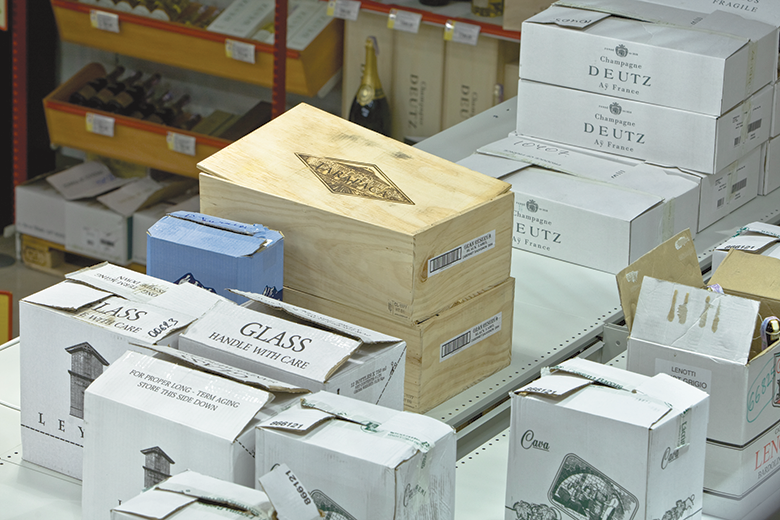
One of the most common questions I get from winery clients is: “My distributor (in a franchise state) has no incentive to sell my brands–he knows I cannot fire him. Do I have any leverage at all?”
This is a valid question: Is there anything a winery can do to encourage performance from a distributor in a franchise state? Failing that, can the winery terminate the relationship?
Written distribution agreements
READ MORE »
Practical Winery & Vineyard
July 2016The Role of Bacteria in Wine
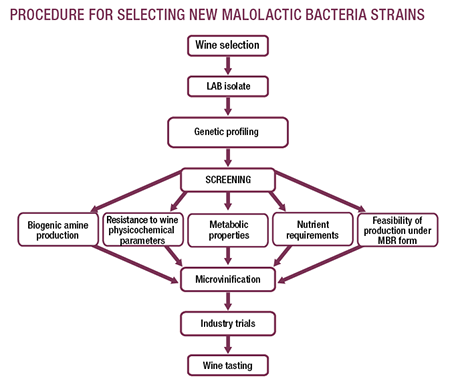 Tasting confirms that in addition to its function of deacidification, malolactic fermentation has an effect on the sensory characteristics of wine
Tasting confirms that in addition to its function of deacidification, malolactic fermentation has an effect on the sensory characteristics of wineThe role of malolactic fermentation (MLF) in red wines and many white wines is constantly being studied. Initially recognized as a way to deacidify wine, MLF was adopted because it imparted a degree of microbiological stability and enriched sensory attributes to wine.
READ MORE »
Practical Winery & Vineyard
June 2016Leaf Removal's Influence on Pinot Noir
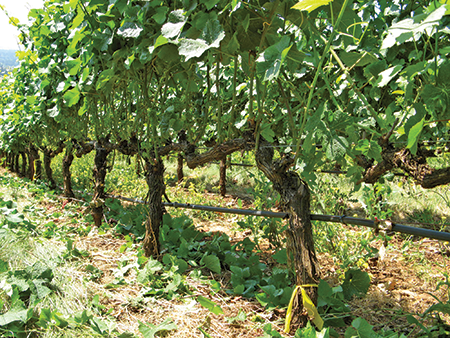 One-hundred percent of leaves are removed from the cluster zone (above), starting from the base of the shoot up to the node above the top-most cluster.
One-hundred percent of leaves are removed from the cluster zone (above), starting from the base of the shoot up to the node above the top-most cluster.Cluster-zone leaf removal refers to deliberate removal of selected leaves around grape clusters. It has been widely used in the vineyards of cool-climate viticultural regions to improve air circulation and sunlight exposure as well as decrease disease pressure.10,44,56
Canopy microclimate is important in determining fruit and wine quality.18,55 A dense canopy with inadequate sunlight exposure can result in poor-quality grapes.34 On the contrary, sunlight-exposed grapes are generally higher in total soluble solids, anthocyanins and phenolics and lower in titratable acidity and malate compared to shaded fruit—although climate conditions may have an important impact.7,21,22
Overexposure to sunlight also leads to greater than optimal berry temperature, resulting in fruit sunburn and inhibition of color development.52 Therefore, determining appropriate levels of leaf removal for optimum sunlight exposure is important for producers to consider when managing vines to yield high-quality grapes.

Grape-derived volatile secondary metabolites play important roles in fruit and wine aroma quality, since they reflect the particular variety, vineyard, regional climate and soil type.41 Only a small portion of grape volatile compounds are present in their free forms, and the majority exist in non-volatile, glycosidically bound forms or other precursor forms.16,59 However, these non-volatile precursors can be converted to the volatile form through enzymatic or chemical hydrolysis during vinification and aging, thus contributing to wine aroma.16,28,29
Little research has been done on volatile composition with leaf removal in red grape cultivars. Many studies investigated the influence of leaf removal on grape-derived terpenoids of white grape varieties; however, results are still inconclusive. For example, in research conducted in British Columbia (Canada), basal leaf removal increased both free- and bound-form terpenoids in Gewürztraminer grapes.44
However, research on Riesling has shown only increases in bound-form terpenoids with leaf removal.45,64 Conversely, in central Europe, wine made from Riesling grapes grown with leaf removal showed no differences in free and bound forms of terpenoids compared to those with no leaf removal, while increases in free- and bound-form terpenoids were observed in Sauvignon Blanc wine by leaf removal.24 Conflicting results may be due to vineyard location, seasonal climate, cultivar, rootstock, timing and severity of leaf removal.
The effects of leaf removal on grape-derived C13-norisoprenoids have not been sufficiently studied. C13-norisoprenoids constitute an important part of the volatile compounds of “neutral” type grapes such as Cabernet Sauvignon,3 Syrah,39 Sauvignon Blanc30 and Pinot Noir.12 These compounds can be formed by direct degradation of carotenoids, or they can be stored as glycoconjugates that release their volatile aglycone during fermentation via enzymatic and acid hydrolysis processes.2,50,59
Sunlight exposure has been speculated to influence levels of C13-norisoprenoid in grapes. R. Ristic et al. reported that after acid hydrolysis, Shiraz wine made from shaded fruit had decreased levels of β-damascenone and 1,1,6-trimethyl-1,2-dihydronaphthalene (TDN) compared to those made from typically exposed fruit.46 Other research has reported either an increase or no change of β-damascenone in shaded grapes.25,27
Fruit-zone shading is a concern in the Pinot Noir vineyards of Oregon’s Willamette Valley due to the high vegetative growth common in the region. Excessive vine growth results from the region’s ample winter and spring rainfall combined with the high water-holding capacity of soils. Therefore, basal leaf removal is commonly applied post-fruit set in vineyards throughout the region. However, it is unclear what level of leaf removal is required to achieve optimal quality. A three-year study was designed to investigate varying intensities of basal leaf removal on Pinot Noir grape quality with a focus on volatile compounds and their precursors.
Materials and methods
READ MORE »
Practical Winery & Vineyard
April 2016Why Wine Producers Hate Franchise Laws
Editor’s Note: This is the first installment in a two-part series about franchise laws by attorneys John Trinidad of Dickenson, Peatman & Fogarty and Suzanne DeGalan of Hinman & Carmichael. DeGalan’s article about how wineries can protect themselves while engaging wholesalers in franchise states will appear in the August issue of Wines & Vines. Wine is meted out for distribution at a warehouse belonging to Southern Wine & Spirits. Nearly half of states have franchise laws that dictate how difficult it is for wineries to change their distribution agreements. Credit: Unex
Wine is meted out for distribution at a warehouse belonging to Southern Wine & Spirits. Nearly half of states have franchise laws that dictate how difficult it is for wineries to change their distribution agreements. Credit: UnexMedia attention descended on Missouri as Diageo geared up to do battle with one of the state’s largest wholesalers, Major Brands, in 2014. The central topic: state franchise laws that make it difficult for a producer to terminate a wholesaler relationship. The Wall Street Journal deemed this the “Missouri liquor wars,” but much of the fanfare went away once the parties settled their dispute in September.
What are franchise laws? READ MORE »
READ MORE »
Practical Winery & Vineyard
April 2016Micronutrients and Calcium Can Reduce Botrytis in Grapevines
Sustainable agricultural practices promote low-pesticide-input farming and integrated pest management programs. It is generally agreed that when overused and misused, conventional pesticides contribute to a rise in pesticide resistance.
Although few plant diseases are completely controlled by the application of fertilizers, Botrytis and many other diseases can be alleviated by the proper application and management of plant calcium and micronutrients.28 There is much scientific data to support that micronutrients such as copper, boron, manganese, zinc and iron can reduce the severity of plant diseases by increasing disease tolerance and resistance of plants to pathogens.
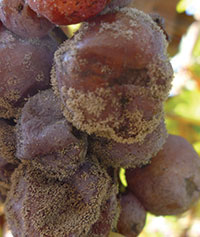
Just as proper nutrition strengthens human health, an integrated pest management program should incorporate proper nutrition and appropriate use of non-traditional soil and plant amendments, such as seaweed and kelp, to strengthen defense mechanisms in plants.29,30
The focus of a fertility program should be on providing appropriate nutrition and preventing deficiencies, rather than waiting for the deficiency to occur. Better tools are needed for testing micronutrients, and the current micronutrient critical values used in soil and tissue testing need to be updated to meet current production levels.1 Potential exists for sampling errors due to in-field variation in nutrient distribution and the non-uniform distribution of plant roots.
Micronutrient availability is dependent on the physical, chemical and biological conditions of soil, weather, root activity, translocation and microbial activity. Cold soils in the spring can result in low microbial and root activity, low micronutrient uptake and micronutrient cations moving slowly in soils. The micronutrients, iron, manganese, copper and zinc demonstrate poor translocation in plants, causing the micronutrients to move only about 0.25 inches in the plant. As a result, during periods of high plant growth (such as flowering), it is common for plants to exhibit transitory micronutrient deficiencies.
There are two types of immunizing responses in a plant: systemic acquired resistance (SAR), a direct response to infection, and induced systemic resistance (ISR), a response to some exogenous chemical with no associated infection. When a plant is nutrient-deficient, its defense responses can become impaired. Micronutrients can control or reduce pathogen damage to the plant by direct toxicity to the pathogen or by promoting ISR.31 Applications of nutrients such as manganese, copper and boron can, through cation exchange, release calcium from cell walls.2,3 Once released, the calcium ions act together with salicylic acid to trigger a SAR response.2,3
Calcium
READ MORE »
Practical Winery & Vineyard
April 2016Managing Mineral Nutrient Efficiency
External pressures on mineral nutrient use in vineyards come from a couple of directions. On one hand, to remain competitive in the global wine market, grapegrowers need to contain applied mineral nutrient costs even while global fertilizer demand is growing and increasing the cost of some fertilizers. On the other hand, our society increasingly expects applied mineral nutrient resources either to stay in vineyards or to leave only with the harvested fruit. These pressures, originating from disparate sources, converge on mineral nutrient use efficiency.
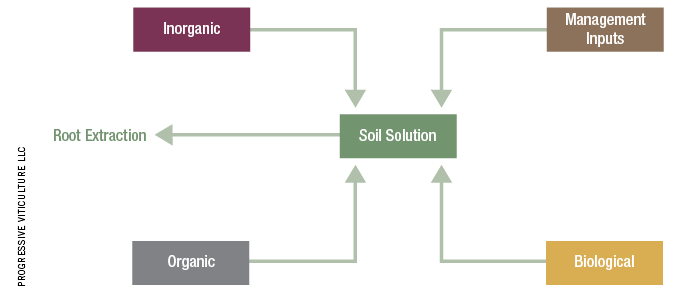 Mineral nutrient pools affect the nutrient content of the soil solution.
Mineral nutrient pools affect the nutrient content of the soil solution.Three primary factors influence mineral nutrient efficiency. They are technological, environmental and grapevine factors. Recently, the technological aspects of applied nutrients have been a common topic in the agricultural press and at agricultural gatherings, often using the construct of the “four R’s.” That is, utilizing the right nutrient source at the right rate and the right timing, and applying it in the right place that is easily accessible to plants.
Fortunately, many wine grape growers are technologically competent, having a wide range of nutrient formulations, effective delivery systems and a basic understanding of soils and vine nutrient demand to which fertilizer applications can be synchronized. Optimum mineral nutrient efficiency, however, broadly encompasses other factors.
The soil solution lies at the center of vineyard mineral nutrient action: It is the water and dissolved substances that reside in soil pores. Among these substances are plant mineral nutrients. Grapevines, in fact, acquire nearly all of their mineral nutrients from the soil solution.
Mineral nutrient concentrations within the soil solution are in a constant state of flux due to many factors. First, water additions dilute them, while water losses concentrate them. Second, weathering of soil minerals and decomposition of organic matter slowly add mineral nutrients to the soil solution while plants and microorganisms consume them (see illustration).
Depending on texture and the general chemical environment (pH), a large portion of dissolved mineral nutrients may be removed from the solution before vines have an opportunity to take them up. These losses are mainly due to precipitation, adsorption and fixation reactions. After heavy rainfall, water percolating below the root zone carries dissolved mineral nutrients away. Last—but not least—irrigations, fertilizations and amendment applications have significant influences that overlay the natural processes listed above.
Optimizing mineral nutrient efficiency
READ MORE »
Practical Winery & Vineyard
March 2016Considering Mineral Nutrient Interactions
Excessive flower abortion is evident in a fledgling grape cluster.Mineral nutrients applied as fertilizers do not move in a straight line from the point of application into grapevines; their journey is fraught with obstacles and detours. Moreover, the 13 essential plant nutrients may interact with one another along the way. Positive interactions occur when the presence of one nutrient enhances the activities of another. Negative interactions occur when one nutrient interferes with or suppresses another. Some noteworthy mineral ion interactions are reviewed below.
Nutrient interactions in vineyard soils
READ MORE »
Practical Winery & Vineyard
February 2016Innovative Tools for Stave Selection and Toasting
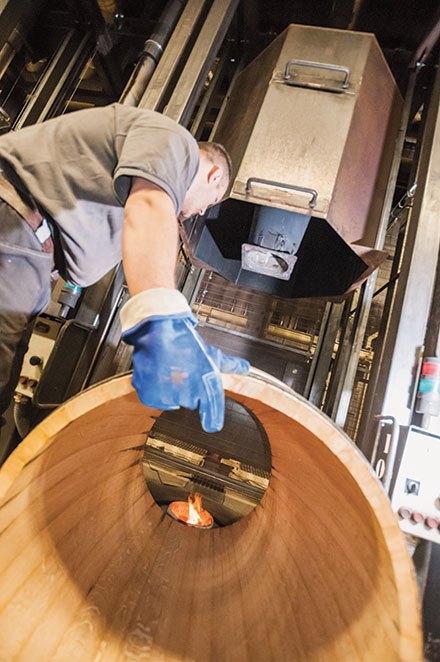 The toasting system has an inner cone covering the flame and an outer dome that eliminates environmental fluctuations.
The toasting system has an inner cone covering the flame and an outer dome that eliminates environmental fluctuations.While variation in oak barrels’ contribution to wine is generally accepted by winemakers, this variation can have unintended impacts on wine composition and the economics of production. To reduce this variability, it is important to understand oak chemical composition.
READ MORE »
Practical Winery & Vineyard
February 2016Loss of Pinot Noir Color and Polymeric Pigment
Wine quality is determined by many different sensory attributes including aroma, taste and mouthfeel. For red wines, color is an additional sensory attribute that plays a significant role in perceived quality.13 This is particularly true for lighter colored red wines such as Pinot Noir. Because of this, a large amount of research has been conducted to understand factors that impact red wine color so that viticultural or winemaking practices can be modified to improve it. Red wine color primarily results when anthocyanins present in the skins of red grapes are extracted while the skins remain in contact with the fermenting juice.9
READ MORE »
Practical Winery & Vineyard
January 2016A Taste of What's to Come
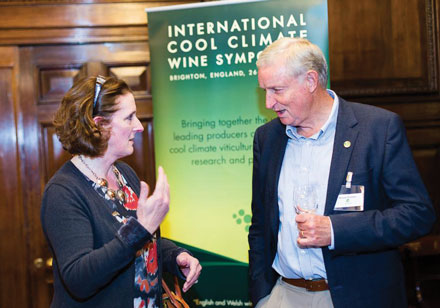 International Cool Climate Wine Symposium patrons Julia Trustram-Eve and Bruce Tindale from High Clandon Cuvee attend the Patrons Circle Drinks event.
International Cool Climate Wine Symposium patrons Julia Trustram-Eve and Bruce Tindale from High Clandon Cuvee attend the Patrons Circle Drinks event.In May, the ninth International Cool Climate Wine Symposium kicks off in the United Kingdom town of Brighton. More than 40 eminent speakers from around the world will share the latest research and innovations for cool-climate viticulture and winemaking. In advance of ICCWS 2016, we spoke to three keynote speakers to gain insight about the content they will share.
READ MORE »
Practical Winery & Vineyard
January 2016New Hub for Wine Studies
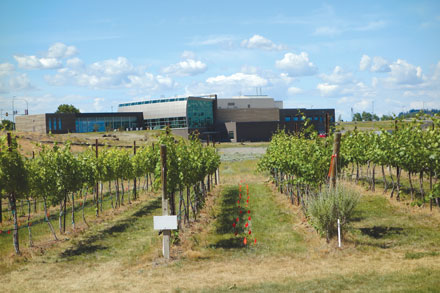 The Wine Science Center is located adjacent to a trial vineyard planted in 2014. Trial plantings will complement the university's growing viticulture program.
The Wine Science Center is located adjacent to a trial vineyard planted in 2014. Trial plantings will complement the university's growing viticulture program.Imagine a facility where the best equipment and high-tech laboratories are dedicated to the study of enology and viticulture in Washington state. Imagine that facility is dedicated to researching unique regional grapegrowing and winemaking challenges and opportunities as well as teaching students the best practices in winemaking to prepare them for careers in the Washington wine industry. That was the vision of the Wine Science Center Development Authority, a collaboration between the city of Richland, Wash., Washington State University (WSU) and industry stakeholders. In 2015, that vision was realized in the new Ste. Michelle Wine Estates WSU Wine Science Center (WSC) at WSU Tri-Cities in Richland.
READ MORE »
Practical Winery & Vineyard
January 2016Nitrogen Plays Many Roles During Fermentation
Nitrogen is a key factor that has a significant impact on wine fermentation. It is the most important yeast nutrient, influencing both fermentation kinetics and wine quality. In this article, we look at the different forms of nitrogen used by yeast and their impact on wine.
READ MORE »
Practical Winery & Vineyard
January 2016Breeding for Drought-Tolerant Vines
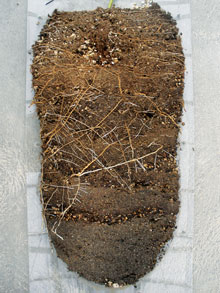 A Riparia Gloire vine displays lateral root growth following four weeks of green-house culture in a rhizotron. The green stem at top-center is a vine trunk.
A Riparia Gloire vine displays lateral root growth following four weeks of green-house culture in a rhizotron. The green stem at top-center is a vine trunk.California is a thirsty state with an erratic supply of water. The most populous state in the nation, California serves the water needs of approximately 38 million individuals--nearly 12% of the entire U.S. population. California added roughly 3 million people in the past 10 years, and estimates of growth for the next 10 years look similar. Taking into account that California's irrigation-fed agricultural sector is vital to the food needs of the state and nation, and considering that climate change could further destabilize an already unpredictable water supply, it is important to find ways to conserve water wherever possible.
READ MORE »
Practical Winery & Vineyard
December 2015Oxygen Transfer Rate in Oak Barrels
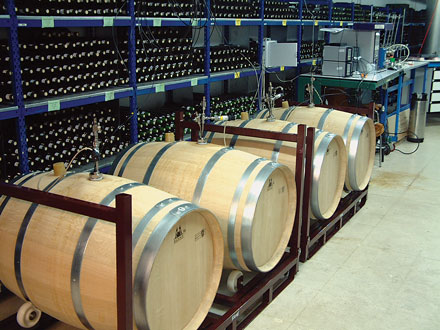 Four American oak barrels were tested 23 times within one year to determine the evolution of oxygen uptake velocity, which demonstrated a slowdown of the oxygen transfer rate.
Four American oak barrels were tested 23 times within one year to determine the evolution of oxygen uptake velocity, which demonstrated a slowdown of the oxygen transfer rate.Aging wine and other alcoholic beverages in oak barrels is a common practice in most wine regions of the world. The interactions between wood compounds and wine have been extensively studied. However, information regarding the supply of oxygen into wine in barrels is limited.
READ MORE »
Practical Winery & Vineyard
December 2015Leelanau Peninsula Winery Owners Reflect
.jpg) Leelanau Wine Cellars grows Chardonnay (left) and Pinot Noir (right) at its vineyard established in 1991.
Leelanau Wine Cellars grows Chardonnay (left) and Pinot Noir (right) at its vineyard established in 1991.With 24 active and growing wineries, Leelanau Peninsula is Michigan’s largest AVA for wine production, if not for tourism. In 2013 there were 700 acres planted to vines on the Leelanau Peninsula, more than one quarter of the 2,500 total vineyard acres in Michigan’s four AVAs. Most vineyards are up to 15 years old, and only a handful are 40 years old.
READ MORE »
Practical Winery & Vineyard
November 2015British Columbia Wineries
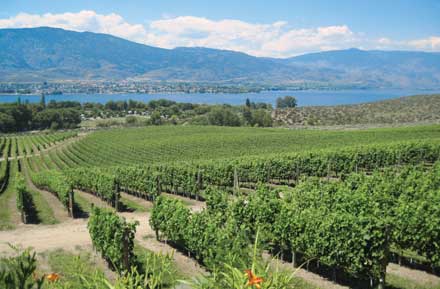 The vineyards of Nk'Mip Cellars are located on the eastern shore of Lake Osoyoos.
The vineyards of Nk'Mip Cellars are located on the eastern shore of Lake Osoyoos.Wine production, quality and tourism are booming in the Okanagan Valley, the predominant wine district of five within British Columbia, Canada. The other officially designated viticultural areas are: Fraser Valley, Gulf Islands, Similkameen Valley and Vancouver Island.
The boom enjoyed by 107 wineries in the Okanagan Valley has been generated in great part by the region’s proximity to economically vibrant Vancouver and petrochemical- and cattle-rich Calgary, thereby minimizing sales and marketing expenditures to other parts of Canada or export markets.

Grapegrowing has existed since the 1850s, with the “modern era” beginning in the early 1990s, following the provincial government’s NAFTA-induced scheme to replace labrusca with vinifera and British Columbia’s Vintners Quality Alliance (VQA) initiative instigated by Harry McWatters (formerly of Sumac Ridge) and Gray Monk’s George Heiss. Labrusca now accounts for less than 1% of total plantings. When the pull-out scheme finished there were 800 planted acres—there are more than 10,000 acres today.
White varieties surpassed red plantings in 2010. Pinot Gris has been the most popular white variety, with Pinot Noir and Merlot the top reds. Whereas the nearness of the Pacific Ocean would lead one to think rainfall during the growing season is an ongoing threat, Okanagan’s southernmost Osoyoos growing district is the only official desert of the “great white north.”
Coming from diverse backgrounds and types of winemaking experience, the five winery leaders interviewed have unique stories to share.
Andrew Peller Ltd.
READ MORE »
Practical Winery & Vineyard
November 2015Premium-Minded Consumers Split Wine Market
California’s wine industry will continue to split most of its sales above and below the $10-per-bottle mark, enjoying a rise in overall consumption and a growing emphasis on premium wines, according to wine industry leaders who participated in a 2015 survey of CEOs conducted by the University of California, Davis.

Results from the survey of wine executives were presented Sept. 22, during the Wine Industry Financial Symposium at the Napa Valley Marriot in Napa, Calif.
Challenges remain in the form of consolidation in the distribution and retail arms of the industry as well as in water and other environmental issues, the survey respondents noted.
“The good news is that as consumers ?become more knowledgeable about wine, they are trading up for premium wines and pulling the entire wine market up with them,” said Robert Smiley, professor and dean emeritus of the UC Davis Graduate School of Management.
“This means that, more than ever, competing wineries need to be investing in their quality lines and in branding,” Smiley added. “This could be challenging for some companies because the cost of land and grapes is now higher than ever, partly due to a recent wave of outside investors who have set their eyes on the wine industry.”
Survey of wine executives
READ MORE »
Practical Winery & Vineyard
October 2015Gushing of Sparkling Wine at Disgorging
Although few scientific studies have been carried out regarding “gushing” during the disgorging of sparkling wines, many factors have been implicated in the phenomenon. These factors include phenolic compounds (particularly tannin, such as excess addition of tannin in the tirage), bottle shaking, ambient temperature during disgorging, insufficient bottle cleaning, cork dust, ultraviolet (UV) lighting in the disgorging area (especially natural sunlight from open doors or through windows onto bottles waiting to be disgorged), incomplete riddling prior to neck freezing, lack of tartaric acid stabilization, calcium crystals and protein instability.6,10,16,17

Wine loss from gushing causes financial loss in addition to a decline in bottling-line speed and efficiency.6
Studies that focused on beer gushing found that some proteins (hydrophobins and lipid transfer proteins [LTPs]) can be responsible, even at very low levels (ppb scale), for beer gushing.18,19,20 These proteins are excreted from some fungi (Fusarium and other barley contaminants) and remain stable during the beer-production process. It is likely that some grape contaminants could exhibit the same behavior in sparkling wine as previously described in beer.6
READ MORE »Practical Winery & Vineyard
October 2015Timely Trunk Renewal to Overcome Trunk Disease
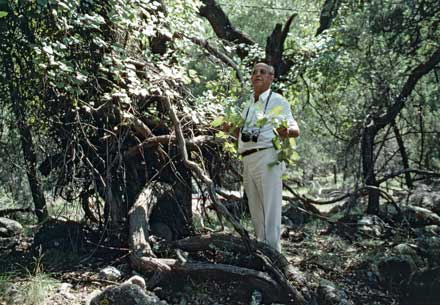 Dr. Pierre Galet, French scientist, with a native Vitis Berlandieri vine in the Davis Mountains of Texas.
Dr. Pierre Galet, French scientist, with a native Vitis Berlandieri vine in the Davis Mountains of Texas.Trunk diseases threaten vineyards around the world, and the International Organization of Vine and Wine (OIV) has now taken an active interest. This column describes a new systematic approach to overcome trunk diseases in mature vineyards. The basic concept of timely trunk renewal (TTR) is certainly not new, but the application to trunk disease—especially to entire vineyard blocks—is practiced by very few growers.
Trunk renewal is not a new process for California. University of California Extension workers Jim Kissler and Bob Sisson used trunk and cordon renewal in the 1980s and showed that that retraining from the cordon or the trunk works very well for infected vines.

However, the process and its application to the present battle with trunk diseases generally has been overlooked. The present emphasis in California is to encourage early preventative practice such as double or late pruning and wound protection with chemicals.
In the past five years I have interacted with many scientists in the international trunk disease research community. Several of them made useful comments on a draft protocol for trunk renewal, which have been incorporated below.
Grapevine trunk diseases
READ MORE »Practical Winery & Vineyard
September 2015Understanding Soil Organic Matter
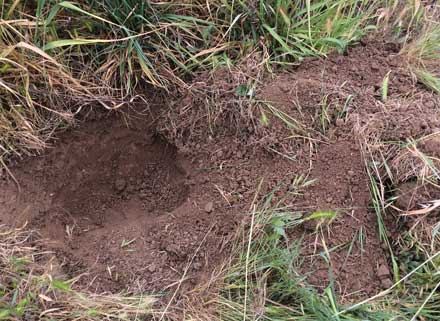 Ungrazed natural range pasture soils: Knights Valley, Sonoma County. Well established Bunch grasses with deep roots. Much organic matter on and near the Suther Loam soil surface.
Ungrazed natural range pasture soils: Knights Valley, Sonoma County. Well established Bunch grasses with deep roots. Much organic matter on and near the Suther Loam soil surface.Although organic matter is important in soil, viticulturists usually do not think much about it. They are too busy managing their crops and vines, controlling pests and diseases, irrigating, organizing labor and doing other things. Plus, many viticulturists think that supplying organic matter to soil is too costly.
READ MORE »Practical Winery & Vineyard
September 2015Best Safety Practice: Entry into Permit-Required Confined Spaces
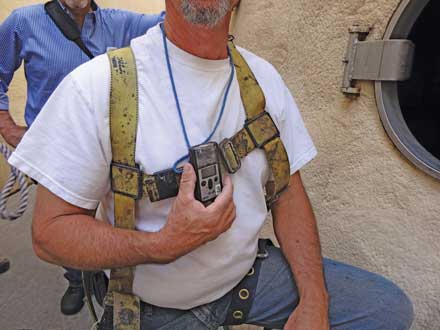 An authorized entrant equipped with harness and personal atmospheric monitor prepares to enter a wine tank.
An authorized entrant equipped with harness and personal atmospheric monitor prepares to enter a wine tank.Constellation Brands management teams in the Central Coast region contacted California Health & Rescue Training to assist them in developing a confined space training program in late 2014. They felt strongly that confined space entries continue to be a highly dangerous operation, and they wanted to enhance the training of all personnel. They had identified specific personnel within their facilities that they wanted to focus specialized training for in order for them to provide in-house training of other employees.
READ MORE »Practical Winery & Vineyard
September 2015How SO2 Additions Influence Microbial Diversity During Fermentation
The use of sulfur dioxide (sulfites or SO2) in winemaking is hardly a new technology-it has been used since the Romans started burning sulfur candles in emptied barrels to keep them from turning sour. The general antimicrobial and antioxidant effects of SO2 in wine have also been well known for several decades, and many modern winemakers find SO2 to be a key additive for producing (and preserving) premium quality wine.
READ MORE »Practical Winery & Vineyard
August 2015Microbial origins of key wine aromas: HIGHER ALCOHOLS and VOLATILE PHENOLS PART III
When a winemaker typically thinks of volatile phenols, usually the first compounds to come to mind are 4-EP and 4-EG, which produce an unpleasant “Band-Aid” or “barnyard” like aroma. However, there are volatile phenols that are intrinsic to the aroma of some wines; such is the case with 4-vinylphenol and 4-vinylguiacol, which provide Gewürztraminer with a carnation and clove-like aroma.

In terms of sensorial impact, higher alcohols (fusel alcohols) in distillates are a major concern. These compounds can provide the consumer of the distilled product with an unpleasant “solvent-like” aroma. In wine, these compounds can produce a pleasant earthy/mushroom aroma that is commonly associated with wines made from botrytis-affected fruit. Also, fusel alcohols can contribute positively to the aroma of an aged wine.
Higher alcohols
READ MORE »Practical Winery & Vineyard
August 2015LANGETWINS, ACAMPO, CALIF. New bottling equipment installation
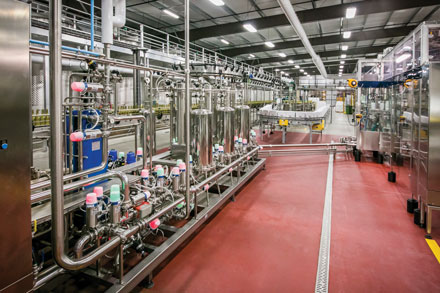 Wine microfiltration and clean-in-place wine skid at LangeTwins Winery and Vineyard.
Wine microfiltration and clean-in-place wine skid at LangeTwins Winery and Vineyard.New bottling equipment has been installed at the LangeTwins Winery and Vineyards in Acampo, Calif., to expand bulk wine, custom winemaking and juicing services in addition to wine grape production and processing of LangeTwins’ own wines.
READ MORE »Practical Winery & Vineyard
August 2015Consumer perceptions of wine brand names
 Novelty brand names like Wild Thing tend to surprise the consumer.
Novelty brand names like Wild Thing tend to surprise the consumer.A Maori-owned wine company in New Zealand asked us: “What does a Maori brand name mean to wine consumers?” We had to admit that we did not know the answer to this question, and we could not find one in academic literature either.

This led to the formation of a project team to a) categorize the wine brand names in New Zealand, and b) examine consumer perceptions of these brand name categories in terms of quality, price, purchase intentions and ability to pronounce and ask for the brand by name.
Literature
READ MORE »Practical Winery & Vineyard
July 2015Correlation between wood extractives and sensory perception in oak-aged wines
Élevage of wine is one of the essential steps in the elaboration of great wines. However, it is well known that sensory results of élevage are not often consistent and predictable. This gives the operation charm because it has an artisan character. But today winemakers desire to obtain results as consistent and as close as possible to their expectations.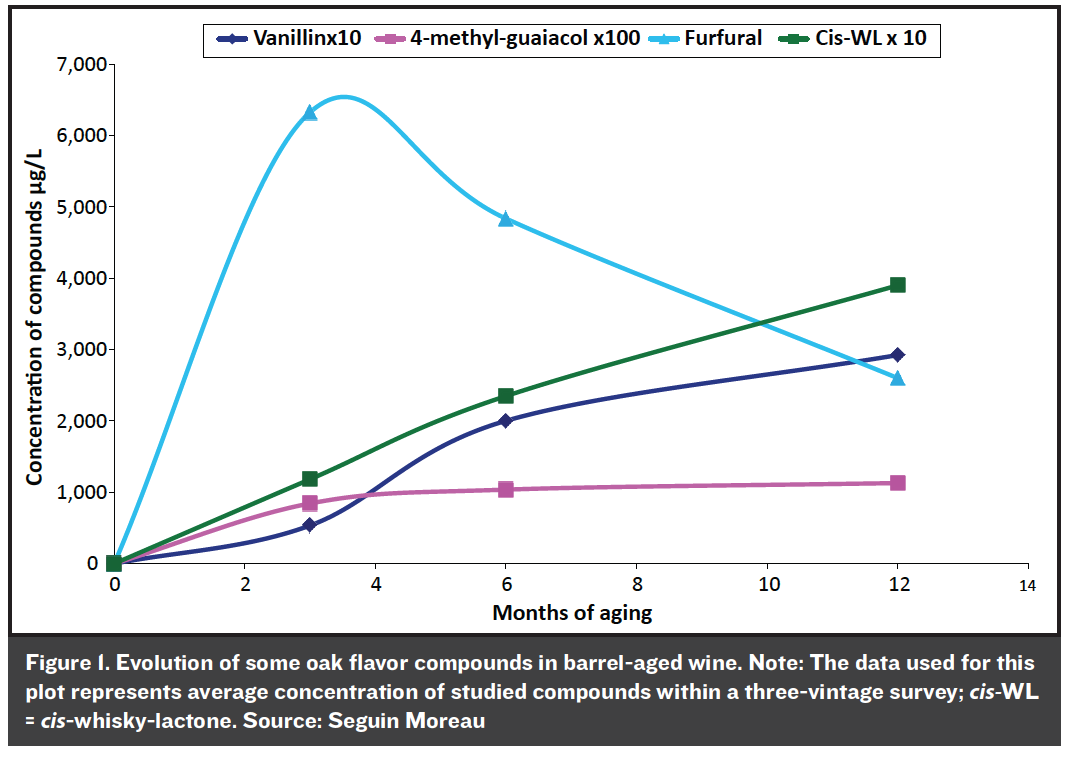

That is why a robust model using the chemical analysis of wood as input data and allowing the prediction of sensory perception of wood in wine is required. The major difficulties to overcome for development of such a model are the natural variability of wood extractives, knowledge of wood compounds’ evolution during élevage and the topic we will see in more detail below: the complexity of the interaction between oak flavors and wine components.
Sensory-active wood compounds’ evolution in wine
READ MORE »Practical Winery & Vineyard
July 2015Search for Zinfandel genetic diversity
A Zinfandel Heritage Vineyard Project was initiated by Dr. Jim Wolpert of the Department, of Viticulture & Enology at the University of California, Davis, in the early 1990s with the goal of finding greater genetic diversity in Zinfandel.

In 1990, there were 34,000 acres of Zinfandel growing in the state, and only four registered clonal selections available from Foundation Plant Services. The registered selections were considered to make low colored wines from very large berries and compact clusters prone to bunch rot. Clearly, more genetic options were needed.
Wolpert began a search for Zinfandel selections in vineyards scattered across California that were 60 years and older, and assembled a collection team consisting of UC Davis emeritus specialist Amand Kasimatis, and farm advisors Glenn McGourty, Rhonda Smith, Paul Verdegaal, Ed Weber, Jack Foott, Janet Caprile and Donna Hirschfelt. The team collected more than 90 cuttings from 13 counties in the hope of improving the diversity of available Zinfandel material. The main characteristics they searched for were small berries, loose clusters and a lack of red leaf virus symptoms.
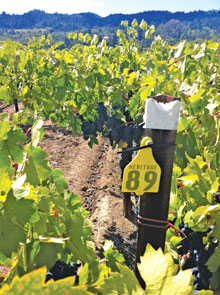 Heritage Zinfandel selection 89 was selected from an El Dorado County vineyard.
Heritage Zinfandel selection 89 was selected from an El Dorado County vineyard.History of Zinfandel in California
READ MORE »Practical Winery & Vineyard
July 2015BOOK EXCERPT: Understanding Vineyard Soils, Second Edition
This excerpt is edited from the published book of 280 pages, $39.95 available online at oup.com/us.

Chapter 6: Putting it all together
READ MORE »Practical Winery & Vineyard
July 2015Managing nutrition of wine bacteria to minimize the effect of inhibitors Part II
Winemakers are aware that Oenococcus oeni bacteria, traditionally responsible for malolactic fermentation (MLF), are successful only if they can adapt to the harsh environment of a fermenting must or a finished wine.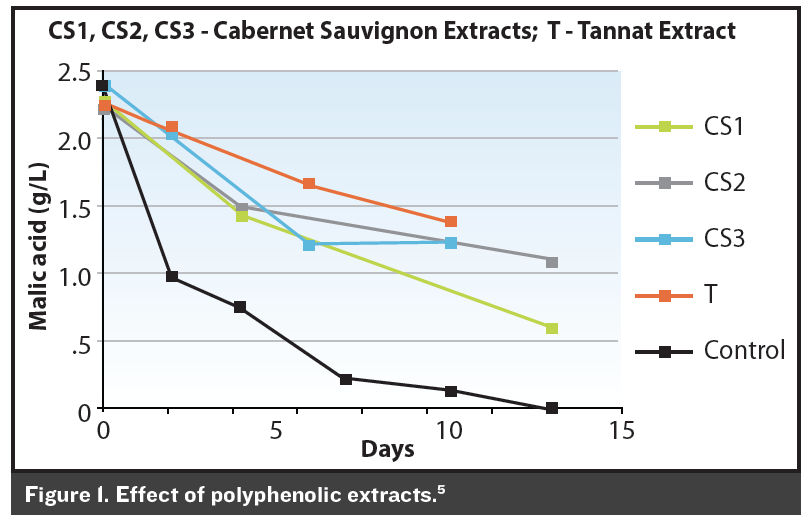
The known complex nutritional requirements of wine lactic acid bacteria (LAB) and the use of tools to facilitate the onset and progress of the MLF when nutrient availability is limiting were discussed in Part I of this report.
LAB are capable of growth under harsh conditions in wine because of a dynamic balance between components that both favor and inhibit their growth and survival. Polyphenols can exert stimulating or inhibiting effects on bacterial growth and activity depending on the strain, as well as the nature and concentration of the polyphenols tested.1,2,4,6

Many wine polyphenols are combined with other compounds that tend to minimize their toxic or inhibitory effects, thus allowing the MLF to proceed. In wines that contain a large proportion of condensed tannins, a strong inhibition of MLB is observed.3,7,8
Trials were conducted with the goal of exploring the impact of different polyphenolic fractions on MLF.5 Polyphenolic extracts were prepared from Merlot, Cabernet Sauvignon and Tannat and added to Chardonnay wine at the same level present in the red wine from which they were extracted. Results are shown in Figure 1.
MLF was completed in 13 days in the control, but between 1 and 1.5 g/L of L-malic acid remained in the wine that received polyphenolic extracts. The polyphenolic extracts caused a significant slowing of L-malic acid degradation.
Figures 2 and 3 depict results of adding inactivated yeast preparations Y1 and Y2 on polyphenolic inhibition.
As can be seen in Figures 2 and 3, LAB growth was stimulated when bacterial nutrient preparations Y1 or Y2 were added compared to the declining LAB populations observed when Y1 or Y2 were not added. These preparations were instrumental in eliminating the inhibiting effect associated with the polyphenolic extracts. The nutrients may exert their effect by binding with, and inactivating, tannins which would lessen their toxicity toward LAB.
The results of a similar experiment to determine the effect the nutrient Y1 (ML Red Boost) on a Tannat wine are shown in Figure 4. In order to decrease tannin inhibition, ML Red Boost was added to the wine 24 hours before addition of the three strains of malolactic bacteria. This timing of addition exerted a pronounced effect upon the rate of development of the malolactic bacteria.
Eight days after inoculation, populations of LAB strains A and B were 60% higher in the wines treated with ML Red Boost. For strain C, the LAB population in the wine treated with ML Red Boost was eight times higher than in the non-treated wine. Figure 4 shows that two weeks after inoculation, all wines supplemented with ML Red Boost exhibited very large LAB populations. Figure 5 shows all three LAB strains supplemented with ML Red Boost exhibited a very short duration of the MLF as compared to wines that did not receive ML Red Boost.
Summary
READ MORE »Practical Winery & Vineyard
June 2015Managing nutrition of wine bacteria to minimize the effect of inhibitors Part I
Wine is a stressful environment for lactic acid bacteria (LAB), as acidity, alcohol, SO2 and temperatures below 18° C are all factors that inhibit LAB growth. In addition, during alcoholic fermentation (AF) yeast may produce such growth-inhibiting factors as SO2, medium-chain fatty acids and certain peptides, depleting the wine of available nutrients.
Juice or wine clarification and other enological practices may eliminate nutrients and particulate matter, both of which are necessary to support the growth of wine LAB.
Wine lactic acid bacteria are known to have complex nutritional needs for carbon, nitrogen, vitamins and minerals. When musts or wines are deficient in one or more of these components, a major impact on malolactic fermentation (MLF) may be observed.

Nutrients
READ MORE »Practical Winery & Vineyard
June 2015When winemakers do everything correctly: The Challenges of difficult-to-ferment juices
Stuck and sluggish fermentations not only incur a financial cost to wineries but also negatively impact perceived wine quality. The causes of arrest of yeast fermentation during wine production are relatively well understood.4
Judicious management of fermentation nutrients, microbial competition and temperature dramatically reduces the risk of arrest of fermentation.1,2,3,4
It is also important to select the correct strain for the juice/must conditions, as strains vary in nutrient requirements and tolerance of stress during growth and fermentation.1,2,3,4,6,8

Key factors in strain selection are ethanol tolerance, nitrogen requirements and sensitivity to temperature shocks and presence of other microbes. Such information is often available from yeast suppliers and directly applicable commercially in most cases. However there remain instances of sluggish and arrested fermentations for juices that meet all the existing criteria for successful completion of fermentation.
We have provided fermentation guidelines that have significantly reduced the incidence of problem fermentations in the wine industry (wineserver.ucdavis.edu/industry/enology/fermentation_management/problem_key/index.html). In spite of this success, there remain incidences of arrest of fermentation in California that are not due to any well-documented causes.
The goal of our American Vineyard Foundation-funded project on assessment of difficult-to-ferment juices is to uncover the causes of these chronically challenging wine fermentations that are non-responsive to current best practices of fermentation management. These juices are often sourced from the same vineyard or block of a vineyard along with other similarly managed vineyards and blocks displaying normal fermentation kinetics.
In recent years there has been an increase in the incidence of difficult-to-ferment juices, defined as those that show problematic fermentation issues regardless of nutrient supplementation or yeast strain.6 Some of this is due to the practice of harvesting at higher Brix values, which places more stress on the yeast for completion of fermentation including increasing nutrient needs of the population.
High proline content/low YAN juices
READ MORE »Practical Winery & Vineyard
June 2015Where to install soil moisture sensors
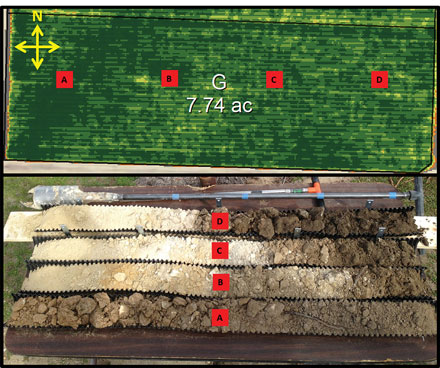 Soil cores extracted to a depth of 4 feet reveal differences in depth of soil horizons across the block.
Soil cores extracted to a depth of 4 feet reveal differences in depth of soil horizons across the block.Grapegrowers are encouraged to use a combination of soil, plant and weather data when determining the length and frequency of irrigation events in vineyards. The most common questions that growers ask about vineyard irrigation are: How often should the vines be watered, and how much water should be applied per irrigation?
Estimation of daily evapotranspiration can tell a grower roughly how much water is removed from the soil, and it is the principal means by which growers can determine the amount of water to apply to a vineyard block. Plant data (such as leaf or stem water potential determined by means of a pressure chamber) is often used to determine how vines are responding to the amount and frequency of water applied.
For example, if a grower wishes to strategically apply less water than the amount lost to evapotranspiration (a deficit irrigation strategy), a plant water status measurement can be used to indicate the degree of water stress the vines are experiencing.
Why measure soil moisture?
READ MORE »Practical Winery & Vineyard
May 2015Predicting harvest date using berry sugar accumulation
Sugar loading can be defined as the accumulation of the quantity of sugar per berry, expressed as milligrams (mg) per berry, from véraison onward. Véraison corresponds with the onset of fruit maturation.READ MORE »Practical Winery & Vineyard
May 2015HACCP Considerations
Plastics are ubiquitously used in the food and beverage industry and are an alternative to traditional packaging materials for wine. Ingredients used in manufacturing plastics may include additives such as heavy metals that act as catalysts in the plastic polymerization process and plasticizers used to modify and improve the applicability and durability of plastics.
Common plastic ingredients include bisphenols and phthalates. Phthalates are typically used to soften plastics and are used in many products from polyvinyl chloride (PVC), lubricants, emulsifying agents, binders and gelling agents, to enteric coatings on pharmaceutical tablets.
Bisphenols, such as bisphenol A (BPA), are used to harden plastics and include polycarbonate plastics and epoxy coatings. Many additives intercalate within plastic polymers and may leach into materials in contact with the plastic.
As plasticizers, phthalates do not chemically bind to the plastics in which they are mixed, and plastic-bisphenol polymers can be hydrolyzed or may be incompletely polymerized, therefore, both types of chemicals can leach from the products into the environment.
Contamination of wine with plastic additives can occur during processing, storage and transport. GC-MS and LC-MS are among the most common analytical tools to analyze for bisphenols and plasticizers.

Plastic ingredients
READ MORE »Practical Winery & Vineyard
May 2015Fate of sulfur fungicide in the vineyard and beyond
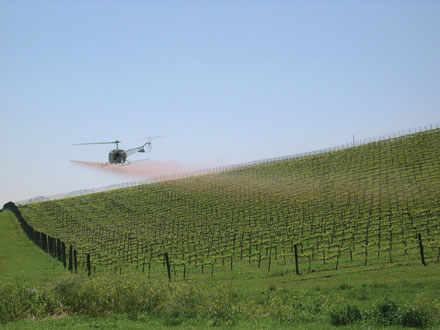 Sulfur spraying by helicopter in a Carneros vineyard experiencing a wet spring.
Sulfur spraying by helicopter in a Carneros vineyard experiencing a wet spring.Several decades of research have characterized the ecological effects of fossil fuel-derived sulfur deposition on temperate forests in the northeastern United States and Europe. These studies demonstrated that high sulfur loads in acid rain cause soil and surface water acidification,4,5 base cation depletion in soils,13 changes to forest structure and function,12,16 and production and bioavailability of other elements including methyl mercury.6,7

In agricultural systems, sulfur is purposely applied as a fungicide, pH regulator and vital plant nutrient.15 Unlike in forested ecosystems, there has been little research to examine the pathways and ecological consequences of its use within and downstream of agricultural systems; most research to date has focused on crop sulfur requirements,1,2,9,14 the relative efficacy of sulfate (SO42-)-supplying fertilizers17 and the effect of elemental sulfur oxidation on soil pH and SO42- availability.8,18
In vineyard agriculture, application of elemental sulfur is a common practice for controlling powdery mildew. In the Napa Valley of Northern California, 810.5 Mg of elemental sulfur are applied to the region’s 47,980 acres of vineyards each year.3
During the growing season, which coincides with the dry season in Northern California (April through October), growers broadcast-spray sulfur by tractor frequently (every seven to 14 days) at low doses (often approximately 5 to 12 pounds per acre) targeting vines but also dusting the soil between trellises. On average, these applications add up to 100 to 300 kg (220 to 661 pounds) of sulfur per hectare per year and are made in wettable or dust form, depending on the vineyard’s individual sulfur program.
The potential environmental consequences of sulfur in major winegrowing regions have been largely unexplored. More broadly in the agricultural sector, many believe that sulfur is inert in the environment. Researchers have not investigated whether targeted applications of sulfur may have consequences for soil and water quality locally within vineyards, or the timing and fate of sulfur moved by water off-site. The ecological consequences of applied sulfur in vineyards may be similar to historic, inadvertent sulfur deposition to temperate forested ecosystems.
In this research, we evaluated the major chemical transformations of elemental sulfur occurring during the growing and dormant seasons in vineyards, and the patterns of sulfur application, storage in soils and export in water flow paths that determine the annual sulfur cycle.
Two vineyard locations in Napa Valley, Calif., were used by our research group to evaluate the immediate fate of applied sulfur on the soil surface and sulfur retention within and loss from vineyards. We hypothesized that growing season conditions favored rapid chemical reaction of elemental sulfur to sulfate on the soil surface, which would be moved by water off-site during dormant season storms. Thus, we hypothesized that the hydrology of vineyards is a major driver of the fate of applied sulfur.
Studying the fate of applied sulfur in vineyards
READ MORE »Practical Winery & Vineyard
April 2015Sanitation of wine cooperage with five different treatment methods
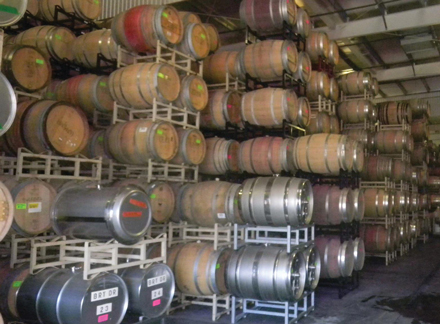 Oak barrels are expensive, made of porous, layered wood, and inevitably harbor microorganisms. Sanitizing them can be a challenge.
Oak barrels are expensive, made of porous, layered wood, and inevitably harbor microorganisms. Sanitizing them can be a challenge.Oak barrels are a particularly challenging part of winery sanitation. While there are many sanitizing options available, rigorous, side-by-side comparisons are required to know which treatments are more or less effective.
In a recent study, we compared five sanitizers: sulfur dioxide, peroxyacetic acid (PAA), steam, chlorine dioxide and ozone at varying times or concentrations. The sulfur dioxide, steam, ozone and PAA at higher concentrations were all found to be effective sanitizers, but the lower concentration of PAA and chlorine dioxide did not significantly reduce the number of spoilage organisms. As with any sanitizing treatment, it is important first to have an effective cleaning step to remove dirt and debris.

Introduction
READ MORE »Practical Winery & Vineyard
April 2015Always read the contract
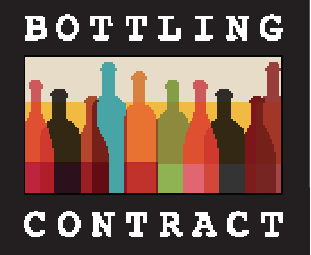
You send your Chardonnay to a custom-crush facility for bottling. One month later, the wine in one of every 10 bottles is brown—oxidized in the bottle. You are forced to pull all your Chardonnay from the market at significant expense, and you fear your brand has suffered.
All evidence suggests the wine oxidized during bottling. Surely the custom-crush facility will step up and compensate you for your damages? To the surprise of many vintners, the custom-crush facility may escape much or all liability based upon the language in its contract.

Contractual limitations of liability can protect custom-crush facilities, among others, from liability.
READ MORE »Practical Winery & Vineyard
April 2015Small Winery Lending
For small wineries, the road to success is rarely paved in gold. This is especially true as the United States recovers from a recession and a drought plagues much of the West, both of which have made it more challenging than ever for winemakers, growers and other agribusinesses to obtain access to the capital they need.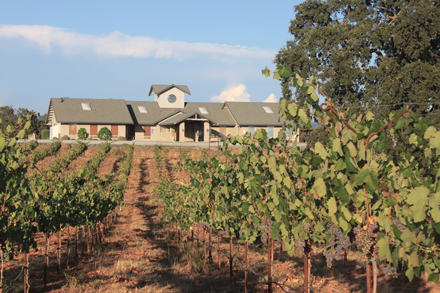 Sera Fina Cellars used SBA financing through Technology Credit Union to expand production.READ MORE »
Sera Fina Cellars used SBA financing through Technology Credit Union to expand production.READ MORE »Practical Winery & Vineyard
April 2015The WEST Without WATER
Abstract
The West Without Water documents 20,000 years in the tumultuous climate of the American West, with tales of past droughts and deluges as well as predictions about the impacts of future climate change on water resources. Looking at the region’s current water crisis from the perspective of climate history, the authors ask the central questions: What is the “normal” climate for the West? Can we count on the benign climate of the past century to continue into the future?
The West Without Water merges climate research with paleoclimate research and introduces readers to key discoveries in cracking the secrets of the region’s past. The book describes how droughts and catastrophic floods have plagued the West with regularity during the past 2,000 years and recounts the most disastrous events in the recorded history of California and the West, including the megaflood of 1861–62.
The authors show that, although the western states have temporarily buffered themselves from harsh climatic swings by building dams and reservoirs, and by making other changes to the natural landscape, they may be unprepared for the effects of climate changes that are occurring now and may continue for hundreds of years into the future. The authors argue that it is time to face the realities of the past and prepare for a future in which fresh water may be less reliably available.
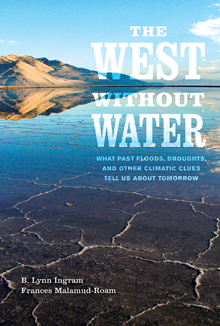
The following is an excerpt from The West Without Water, a 280-page book available from the University of California Press.
Chapter 14: What the past tells us about tomorrow
READ MORE »Practical Winery & Vineyard
March 2015Wine Grape Grower's Assessment in 2015
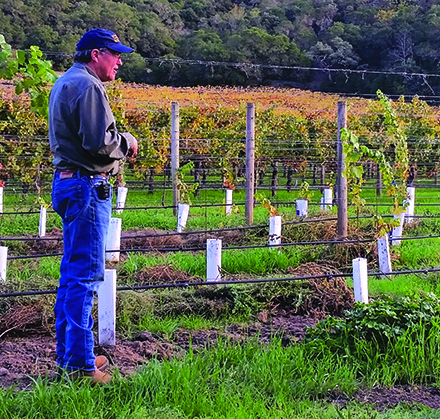 Andy Walker looks over 10 new PD-resistant wine grape selections in November 2014.
Andy Walker looks over 10 new PD-resistant wine grape selections in November 2014.Time may be running out for the California wine industry as we know it,” read the first line of the Wine Spectator cover story on Oct. 15, 2000. One look at the vineyards in Temecula, Calif., in 2000 proved it was a very believable statement.

Between 1999 and 2000, 40% to 60% of the vineyards in Temecula were wiped out. The cause: an old foe of the wine industry, Pierce’s disease (PD), had a new vector, the glassy-winged sharpshooter (GWSS), which had hitched a ride to California from its native range that runs from Texas through Florida, and north to around the Mason-Dixon line.
GWSS was spreading PD in California as never before seen in modern times, first infesting Southern California and then moving north to Bakersfield and Tulare. Experts estimated that, unchecked, GWSS could very well infest regions as far north as southern Oregon.
What happened?
READ MORE »Practical Winery & Vineyard
March 2015Microbial origins of key wine aromas
Volatile acidity and hydrogen sulfide are nearly unanimously classified as wine faults by vintners. Some sulfurous compounds can be pleasant, as is the case with grape-derived thiols that are intrinsic to the passion fruit, box wood and grapefruit aromas of Sauvignon Blanc. However the sulfurous compounds that are purely derived from yeast are not considered valuable to the vintner.
The volatile fatty acids are likely only considered to be contributors of positive aromas by those who produce vinegar. In wine, volatile fatty acids are responsible for a major fault when they accumulate beyond their sensory threshold.

Volatile fatty acids
READ MORE »Practical Winery & Vineyard
February 2015Barrel alternatives supply oxygen to wines during élevage
An integral step in the production of quality wine is élevage in oak barrels. Today it is well understood that, at the end of élevage, wines aged in contact with wood can show organoleptic properties reflecting both a complexity and an originality forming their personalities.
Two physico-chemical phenomena contribute to achieving this change in wine: extraction of volatile and non-volatile wood compounds with simultaneous dissolving of atmospheric oxygen in the wine. Oak is a porous material, permeable to gas, allowing exchanges with ambient air throughout the élevage period.15
READ MORE »Practical Winery & Vineyard
February 2015Carboxymethyl Cellulose -- CMC
Winemakers today are under increasing pressure to get tartrate-stable wines into the marketplace rapidly while considering complicating factors such as method effectiveness, cost impact, energy efficiency and production/bottling logistics.
Consumer preference surveys have shown that precipitates in wine are often viewed unfavorably and can be thought of as flaws in the wine—or even contamination—since tartrate crystals can resemble glass shards in the bottle.
READ MORE »Practical Winery & Vineyard
February 2015PRUNING OF SAUVIGNON BLANC VINES
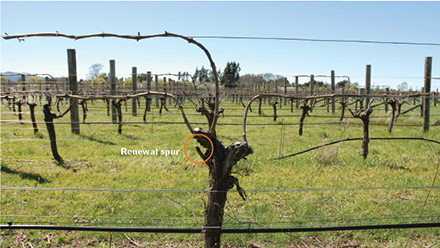 Three-cane Sauvignon Blanc vine in Marlborough, New Zealand.
Three-cane Sauvignon Blanc vine in Marlborough, New Zealand.Pruning is one of the most important aspects of vineyard management, and selecting the optimum cane can be difficult. Although the influence of pruning techniques and training systems on vine growth and yield is well documented,3,4 little is known regarding the influence of cane diameter on yield and gross profit.
Increasing fruit production within a vineyard and improving yield predictions can keep grapegrowing competitive and cost-effective compared to other crops, which compete for land use. As the demand for wine increases worldwide, and the price of land increases, obtaining the most from a vineyard may be a more viable option than purchasing additional land.
Improving yield predictions provides the required information to make informed decisions regarding harvest logistics, potential financial gains, storage space, equipment usage and matching market demand.
Our study investigates the influence of cane diameter on inflorescence architecture, yield and the subsequent gain or loss in gross profit.

Methods
READ MORE »Practical Winery & Vineyard
December 2014A Global Perspective on Regional Wine Identity
All the world is a stage, and we are all players—that is what I told my audience when I spoke at the Southern Oregon Wine Cluster Industry Conference in August 2013. We were gathered near Ashland, Ore., home to the Oregon Shakespeare Festival, which perhaps explains why I invoked the Bard to this group of winegrowers and producers.
“The world is a stage, and all the men and women merely players.” This famous line from Shakespeare is true in general and particularly apt for those of us in the wine business. Wine is certainly local—the product of a particular time and place—but the business of wine is clearly global, with many complicated international impacts and influences.

You might not think of yourself as a global market participant, I told my audience, but consumers are keenly aware of the global stage, because they encounter it—with its hundreds and thousands of players—every time they choose a wine. So long as consumers can entertain choices from around the world, we all are players on the global stage—whether we want to be or not!
Importance of regional reputation
READ MORE »Practical Winery & Vineyard
December 2014Closure Trials Demonstrate Volatile Sulfur Compound Formation
Since its initial groundbreaking closure trial in 1999, the Australian Wine Research Institute has conducted many major commercially funded closure trials, which have provided further understanding of the impact closure selection has on wine development in-bottle and the importance of factors such as total package oxygen (TPO) and storage temperature on shelf life.
From the beginning, these closure trials have sought to understand the complex relationship between the wine matrix, oxygen introduced at bottling, oxygen transmission rate (OTR) through the closure, free SO2 concentration and development of volatile sulfur compounds. To date, the following concepts have been established:
• High levels of oxygen introduced at bottling (TPO) can result in a dramatic reduction in shelf life (sometimes reducing it to less than six months).
• In commercially bottled wines with well controlled TPO, evolution of wine style is typically driven by the closure OTR, especially with longer term storage periods (more than one year).
• White wines are more susceptible to oxygen introduced at bottling and through closure permeation than red wines, resulting in a more pronounced impact on wine style.
Numerous closure trials have shown that oxygen ingress (OTR) is one of the key drivers in determining how a wine will develop after bottling and, ultimately, its expected shelf life. However, understanding of how volatile sulfur compounds form and evolve under different wine closures is still developing.
A significant number of volatile sulfur compounds are found in wine, and the three listed in Table 1 have been shown to be significant in closure studies. While at low levels they can add complexity to a wine, generally they are considered undesirable.

Reversible reactions
READ MORE »Practical Winery & Vineyard
December 2014Overcoming 10 Objections from Beverage Retailers
Choosing your words carefully and understanding how to manipulate a room full of people can go a long way, but sometimes strong interpersonal skills are not enough. Convincing retailers to carry your wine(s) means fielding countless questions and overcoming reservations about your brand.
Being able to manage objections in a sales meeting is a skill that is absolutely necessary in the beverage industry. Some major objections that you are bound to come up against will be your bottle price, the retailer’s resistance to change, their trust in you as a supplier and your wine’s success, any promises they have made with other brands and their need to consult with the rest of the team before taking on your wine(s).
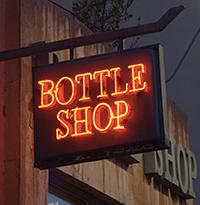
Let’s take a look at how you can plan ahead and be prepared to handle any situation:
Price
READ MORE »Practical Winery & Vineyard
November 2014Preserving East Coast vineyards while catching tax breaks

Vineyard owners can have their cake and eat it too. With wine consumption on the rise and an increase in states allowing winery-direct-to-consumer shipping, it is a great time to be in the wine business.
While starting or running a successful vineyard is the dream for many, it also comes with a hefty price tag. The good news is that a fruitful landowner (pun intended) in many states along the East Coast may also be able to reap rewards through tax benefits or grants.
A conservation or development easement allows vineyard owners to retain their land but give away rights for developing the land beyond agriculture. These easements are an extremely effective way to ensure that private land is protected, because the limitation is binding on future owners of the land as well.
In essence, a vineyard owner gives a private organization or public agency the legally binding right to enforce the owner’s promise not to develop the land in the future. While the land on which the vineyard sits may have a lowered initial value as the result of a conservation easement, the easement’s economic benefits can be worth considering in many states.
The Northeast: Where agriculture is premium
READ MORE »Practical Winery & Vineyard
November 2014IRC §1031 like-kind exchanges for vineyards and wineries

When we consult with clients during the sale of their vineyards and wineries, one question that always comes up is, “How can you minimize our pending tax liability?” While it is necessary to pay taxes on the sale of an asset that has appreciated in value, in this instance there is usually an option to defer the recognition of gain into the future.
Often, a vineyard or winery is sold through an installment sale, where payments are received annually for a specified number of years. In an installment-sale situation, gain is generally recognized as the cash proceeds are received annually. The major issue is the taxpayer still triggers their gain in the near-term as cash is received. However, through the use of an Internal Revenue Code (IRC) §1031 exchange, the gain on the sale of property can be continuously deferred through the exchange of “like-kind” property.
What is an IRC §1031like-kind exchange?
READ MORE »Practical Winery & Vineyard
November 2014Technology will cause Patents to become an issue in the wine industry
None can argue against technology now pervading every aspect of wine production, storage and shipment—from patented grapes, harvesting machinery and methods, to bottling and packaging. Many stories on these topics in Wines & Vines itself illustrate this point.
This march of technology is not unique to wine; many other industries have been subject to an exponential growth of technology. This “technology curve” has affected numerous industries, from the computer sector to medicine to finance. Because of these technology curves in other industries, we have a bit of a crystal ball to envision what will happen with patents in the wine industry.
READ MORE »Practical Winery & Vineyard
November 2014Wine industry leaders adapt to consumer shifts and drought
California wine will hold its own in the global market despite shifts in consumer demographics, scarce water and competition from imported wines, craft beers and cocktails, according to wine industry leaders participating in a new CEO survey conducted by the University of California, Davis.
Results from the survey of wine executives were presented Sept. 23, during the Wine Industry Financial Symposium at the Napa Valley Marriot in Napa, Calif.
READ MORE »Practical Winery & Vineyard
November 2014Why wooden barrels?
Below is an excerpt from chapter one of Wood, Whiskey and Wine, available from University of Chicago Press (cloth, 224 pages, $35) or via amazon.com.
READ MORE »Practical Winery & Vineyard
October 2014Impact of wine matrix on red wine finish and consumer acceptance
The authors thank The Rhone Rangers for support in conducting the research.
READ MORE »Practical Winery & Vineyard
October 2014Freemark Abbey sustains grape and wine quality
One Napa Valley red wine that has a long production history and consistency in style and taste is Freemark Abbey’s Bosché Vineyard Cabernet Sauvignon. With an average case production of 2,500, the vineyard-designate wine comprises about 5% of Freemark Abbey’s annual production, which includes 30,000 cases of Cabernet Sauvignon.
READ MORE »Practical Winery & Vineyard
October 2014How extraction of oak volatiles and ellagitannin compounds affect sensory profile of wine aged with French winewoods
Oak barrels have long been used in fine winemaking—initially for easy handling of wine during production, storage and transport. Oak became accepted for its positive effects on wine development, namely to provide pleasant aromas and the stabilization of red wine color.
READ MORE »Practical Winery & Vineyard
September 2014Brighton, England, will host ninth International Cool Climate Wine Symposium

Brighton, England, will host wine experts from China to Champagne to speak at the ninth International Cool Climate Wine Symposium from May 26 through 28, 2016. A limited number of early-bird tickets are available from the website iccws2016.com at £500 (about $850) + VAT for delegates to save £100 (about $170) off the total conference fee, which includes access to all sessions, master classes, wine tastings, workshops and lunches. Deadline for the early-bird tickets is Dec. 31, 2014.
Brighton is on the south coast of England, which is now recognized worldwide as a premium wine-producing region, particularly for sparkling wine. The United Kingdom is a key international wine market housing some of the industry’s leading education providers, and it is widely considered to be the “shop window” of the global trade. Previous hosts of the symposium include Tasmania, New Zealand, Oregon, Washington state, New York state, Melbourne, Australia, and Germany.
Key United Kingdom wine industry and trade bodies such as the United Vineyards Association, English Wine Producers, Plumpton College and the Institute of Masters of Wine are involved in organizing the symposium. A 50-strong international advisory panel chaired by Chris Foss, head of the Wine Department at Plumpton College (the UK’s center for wine training education and research) is compiling the program.
Laithwaite’s and Lallemand have signed up as major supporters of the symposium. Ann Dumont, Lallemand’s communications manager, explains: “We are delighted to partner with the ICCWS 2016, as Lallemand has a strong commitment to research and education, and our association with the symposium is totally in line with this mission. We are looking forward to the event in the United Kingdom, itself an exciting and dynamic market, and learning about the latest research and advances in cool-climate winemaking.”
Schedule and speakers
READ MORE »Practical Winery & Vineyard
September 2014Meet the new digital frontier: .wine
Three entities have each applied to become registry operator for the “.wine” generic top level domain (gTLD) as part of the new gTLD program, which involves the addition of thousands of new top-level strings to the Internet Domain Name System.1 The .wine applicants foresee this domain string as having significant future breadth of coverage for online wine information, services and resources.
READ MORE »Practical Winery & Vineyard
September 2014Alexana Winery: Gravity flow with flexibility
Alexana Winery is the northern sister of Revana Family Vineyards in Napa Valley and Corazon Del Sol in the Uco Valley of Argentina. Dr. Madaiah Revana had been thinking of developing another winery when a meeting with winemaker Lynn Penner-Ash in a Houston, Texas, wine bar kindled his interest in Pinot Noir. He began looking at various properties in the Willamette Valley, Ore.
READ MORE »Practical Winery & Vineyard
September 2014SMART VITICULTURE
Terroir is a word that seems to appear everywhere now in grape and wine writing. It is almost like a French notional takeover. Many struggle with the exact meaning of the word terroir, but most understand it as an influence of the vineyard on wine style and quality.
There are various definitions of terroir, some of which include the human influence of tradition and history. Most associate the terroir effect closely with the vineyard soil, and I do not have a problem with most of these definitions.
READ MORE »Practical Winery & Vineyard
August 2014Dealing with compromised fruit in the winery

Producing high-quality wines can be difficult even when Mother Nature cooperates and grapes arrive at the winery in pristine condition. However, in some years events occur that thwart the efforts of even the most vigilant and skilled vineyard manger in producing ripe and undamaged fruit.
READ MORE »Practical Winery & Vineyard
August 2014White wine aroma optimization
Winemakers are challenged with allowing a specific lot of grape juice to achieve its full potential as wine and maintain that potential for as long as possible.
Not all grapes are of equal quality, however, so while it is true that the best grapes in the world need very little intervention, others may require more “input” to achieve magic in a bottle.
READ MORE »Practical Winery & Vineyard
August 2014Improving pest management practices
Sonoma County has 60,000 acres of wine grapes, which comprise 6% of its land area. Since that 6% of land area generates approximately 70% of farm gate revenues, wine grapes are critical to the preservation of agriculture in the county.
There are approximately 1,500 vineyard owners in the county, and 40% farm less than 20 acres, while 80% farm less than 100 acres. Wineries farm approximately 21,000 acres, with independent growers farming 49,000 acres.
READ MORE »Practical Winery & Vineyard
July 2014Role of non-Saccharomyces yeasts in wine production

An uninoculated fermentation is often referred to as “natural” or “spontaneous” fermentation that involves the sequential action of different non-Saccharomyces and a diversity of indigenous Saccharomyces yeasts. The first fermentation, looking at the 7,000 years of winemaking history, was more likely the result of serendipity than design.
Natural yeast and natural wine: a rather unnatural tale
READ MORE »Practical Winery & Vineyard
July 2014Good, Bad and Deficit
In arid and semi-arid grapegrowing regions, irrigated viticulture is necessary to support consistent vineyard production. Moreover, well-managed irrigation is an essential part of vineyard practices and can potentially enhance quality.5
Through controlling the amount of water supplied to grapevines, growers have the ability to control shoot growth and canopy size/density (which affect light exposure and air circulation in the fruiting zone), manipulate berry size and modify wine style in the vineyard.18
READ MORE »Practical Winery & Vineyard
July 2014Types of oak grain, wine élevage in barrel
Winemakers always wonder how different types of oak grain will interact with their wines. To answer this, we need to define oak “grain,” which is sometimes misunderstood.
We also need to take a detailed look at élevage, what happens to the wine during time in barrel. In other words, which oak compounds are released, modified and combined—and how does grain impact these compounds?
READ MORE »Practical Winery & Vineyard
July 2014Effect of lag phase thinning on Zinfandel
An underperforming block of young Zinfandel vines with viral symptoms was selected for study. The block is located in the Dry Creek Valley of Sonoma County, Calif., and underwent a thinning experiment in 2013.
The crop on treatment vines was lag-phase thinned by 20% (removal of two to three clusters per vine), approximately 45 days after 50% bloom. Three vine rows were not thinned to act as a control, and they were allowed to progress until 95% véraison, when a green drop pass was made (Aug. 29).
READ MORE »Practical Winery & Vineyard
June 2014Determining impact of hand or machine leaf removal on fruit quality
Our vision of the 2013 growing season was one of easy success in July, two months before harvest. There was limited rain and advanced grape development across the state, something that had been rare in recent years.

However, September proved challenging due to shifts in weather that led to berry cracking and increased fruit rots across much of western Oregon. Questions poured in from industry professionals seeking information about Botrytis bunch rot management and more. Most growers were already using proper preventative measures: appropriately timed fungicide applications combined with judicious cluster-zone leaf removal.
As harvest neared and rains began to fall, heightened concern about fungicide use and pre-harvest intervals (PHI) developed, leading to discussions about cultural management techniques such as leaf removal and culling damaged fruit.
Leaf removal has been well-studied worldwide by numerous researchers (including work conducted in my program at Oregon State University). Those studies varied from the impacts of leaf removal on vine growth to impacts on fruit ripening, berry composition, wine quality and disease potential.
A trial that compared manual and mechanical leaf removal was of particular interest to the industry in 2013 for several reasons: sunburn/heat damage, disease management and labor shortages. Many growers in Oregon have shifted to mechanical leaf removal during the past few years because it can reduce canopy management costs.
We estimate hand leaf removal to cost approximately $270 per acre on average density vineyards (1,245 vines per acre).1 Mechanical leaf removal costs of $25 per acre compared to $130 per acre for hand leaf removal has been reported in California’s Central Coast vineyards with vine densities ranging from 908 to 1,089 vines per acre.3
Perceived drawbacks to mechanical leaf removal include damage to clusters, reduced precision compared to hand-removal and the potential for leaves to remain lodged in dense canopies. Development of new leaf-removal technology and equipment has reduced many of these concerns.
Leaf removal conducted at bloom in 2011: (B) mechanical leaf removal on the east and west sides of the cluster zone, and (C) leaf removal by hand on the east and west sides of the cluster zone.However, applied research is needed to determine how mechanical leaf removal affects key aspects of vineyard production so that growers can make informed management decisions when shifting practices from manual to mechanical methods. This article summarizes relevant findings of a trial conducted to compare hand and mechanical leaf removal in Pinot Noir during 2011, one of the coolest and wettest years in Oregon’s recent history.
Prior to 2011, research was conducted across several commercial vineyards in the Willamette Valley (2008 to 2011) to determine impact of early season leaf removal on powdery mildew (Erisyphe necator) and Botrytis bunch rot (Botrytis cinerea). Results showed that early season leaf removal reduced powdery mildew and Botrytis incidence and severity of clusters when compared to no leaf removal (Skinkis and Mahaffee, unpublished). That research evaluated hand leaf removal only.
Since many growers are switching to mechanical leaf removal, concerns have been raised about applicability of mechanical leaf removal early in the season (bloom or fruit set) without resulting in cluster and berry damage. This led to evaluation of whether hand and mechanical leaf removal would cause cluster damage and influence fruit set, yield, fruit composition and disease incidence when applied at different phenological stages during the 2011 season.
Mechanical and hand leaf removal methods were compared in a commercial vineyard in the Dundee Hills AVA. The vineyard was planted to Pinot Noir (clone 777) grafted to Riparia Gloire rootstock in 1997 at a vine density of 3,015 vines per acre. Vine rows were oriented north-south and trained to a vertically shoot positioned canopy.
Leaf removal was conducted at three phenological stages: bloom, pea-size and bunch closure. Leaves were removed from both the east and west sides of the cluster zone at each of the three phenological stages by using hand labor or mechanically using an Avidor leaf puller attached to an over-the-row tractor. Treatments were applied to plots of 12 vines in a randomized complete block design with six replicates.
Due to the nature of the season and the commercial vineyard’s management policy restricting the use of specific fungicides for Botrytis control, a non-leaf removal treatment was not implemented. However, a third treatment where leaves were removed at bunch closure from only the east (morning) side of the cluster zone was implemented for comparison (an industry standard practice), and leaves were removed either manually or mechanically.
Leaf removal was performed at the start of each time point with clean-up passes to remove new leaves or laterals produced in the cluster zone during each successive phenological stage in the study. Vine growth parameters were monitored including fruit set, leaf area, yield, yield components (cluster weights, berries per cluster, etc.) and pruning weights. Fruit maturity, berry phenolics and incidence of Botrytis bunch rot at harvest were also measured.
Results
READ MORE »Practical Winery & Vineyard
June 2014Unseen process for local/global water footprint and water balance estimates in grapevines
Understanding the dynamics of nighttime transpiration and water rehydration of plants and grapevines has benefited from recent research, with the aim of obtaining amelioration strategies to maximize water-use efficiency for crops in challenging climates.
Recent research on grapevines has challenged the paradigm that C3 and C4 plants do not transpire at night due to complete stomata closure. Grapevine water loss by transpiration at night can reach up to 50% of daytime transpiration, depending on the level of aridity and water stress.19,20
READ MORE »Practical Winery & Vineyard
June 2014Closure selection and pH influence on red wine color and tannin during bottle aging
Changes in red wine color and mouthfeel during bottle aging are influenced by pH and choice of bottle closure. Bottling wines at lower pH and with slight oxygen exposure through the closure can lead to more stable color for the next 24 months and potentially lower astringency.
Red wine astringency is influenced by many factors including tannin concentration, tannin composition and wine matrix components such as ethanol, pH, oxygen and metal ions.
READ MORE »Practical Winery & Vineyard
June 2014Branding your SMALL vineyard
Q: Why do you need to brand your small vineyard?
A: You do not need to if you are happy with average or below-average prices or “the going rate.”Increase potential to obtain top dollar for your grapes. In less than 10 years, Upland Vineyards grape prices have increased by 30% or more.
If you plan to expand your vineyard in the future, branding is important.
Your grapes will eventually only be as good as your brand.
READ MORE »Practical Winery & Vineyard
May 2014Branding strategies in agricultural commodities
Vineyard-designated wine is one lesson in value-added agricultural branding that presents both the winery and vineyard owner or lessee with a number of marketing and legal issues.
Recognition of the value of vineyard-designated names, vineyards have long been designating blocks within their vineyards with proprietary names.
READ MORE »Practical Winery & Vineyard
May 2014Management strategies for drought conditions

California has not seen a drought year like 2014 in recent history. Many vineyards not only have a limited water supply for irrigation, but the water in their root zone is well below the full water-holding capacity. With our rainfall future uncertain, we need to prepare for the worst. Here are four drought-management strategies for your consideration.
The first strategy is artificial rain. Flood, furrow or sprinkler irrigation artificially refills root zone moisture. This recharging ought to occur about three or four weeks prior to bud break to ensure roots emerge from dormancy normally, leading to normal bud break, shoot emergence and early season shoot growth. After that, schedule irrigations as in any other year.
Extensive defoliation of Chardonnay.The artificial rain strategy assumes a supply of water sufficient for both root zone recharge and normal irrigations through the growing season. This assumption, along with the surface irrigation system requirement, is prohibitive for many vineyards.
All three of the next drought-management strategies need the following water-conservation methods for success. First, diligent control of weeds in the vine row to eliminate water loss through their transpiration. Second, disk and ring-roll the tractor rows to remove transpiring vegetation and to make a barrier of loose soil that limits evaporation. Third, thin shoots early (≈ 3 to 6 inches long) and severely (less than six shoots per foot cordon) to reduce transpiration through vines. For the same reason, if canopies grow too large, hedge them to about 14 to 16 nodes per shoot after shoot growth stops.
These strategies also warrant maximum value from applied water. To that end, ensure the best possible drip irrigation system performance with regard to uniformity in pressure, flow and distribution. Also, promote the highest possible infiltration rate into the soil through organic and mineral amendment additions.
The second drought-management strategy familiar to many wine grape growers is regulated deficit irrigation (RDI). The only difference for 2014 is that RDI schedules should have begun three or four weeks before bud break instead of between May and July. This early onset of drip irrigation is necessary to accommodate the drought-induced soil-moisture deficit.
Even with these early irrigations, the soil profile may only contain about 4% to 13% of the moisture that it could if fully recharged from rain. After initiating irrigations, monitor vine moisture status, soil moisture status and evapotranspiration (ET) as you normally would, and irrigate accordingly. The longer RDI season requires more irrigation water than in a normal year, but less than artificial rain due to greater irrigation efficiency and plant water use efficiency.
Stretch the limited irrigation water is the third strategy. Soil moisture status is the primary basis for irrigation schedules, using a specific level of depleted moisture or soil moisture tension threshold as the basis for applying water. This method requires soil moisture sensors within the root zone that are read at regular intervals. Install at least two sensors at each monitoring location: one at about 10 to 12 inches deep for irrigation scheduling and another at 30 to 36 inches to monitor deep soil moisture depletion. The deep sensor indicates when vines become entirely dependent on irrigation water.
It is insightful to have sensors at two locations within one block: one where vines are most prone to water stress and another where they are least prone. With stretch the limited irrigation water, stress-prone areas will become more pronounced than usual. For this reason, they ought to be carefully monitored and irrigations adjusted to minimize the severity of water stress there.
If the water supply was sufficient, the early season soil moisture threshold should be higher than the later season threshold. Irrigating this way moderates water stress and assures complete canopy development. During this time, apply only enough water to maintain a moderate and steady rate of shoot elongation (3 to 4 inch internodes) until reaching full canopy (14 to 16 nodes or leaves per shoot). After that, greater water stress is not only beneficial for water conservation but also desirable for wine grape quality.
For example, an early soil moisture threshold may be -60 to -70 cbars, while later it may -100 to -110 cbars measured with resistance blocks (Watermark sensors or gypsum blocks). Soil moisture content depletion levels may be similarly determined and set for capacitance sensors and neutron probes.
Keep the vines alive is the last strategy and last resort. Under this strategy, apply water only when necessary to prevent complete defoliation. As such, irrigation scheduling depends almost entirely on visual observations of canopy condition. As with the stretch the limited irrigation water strategy, focus your observations on the areas prone to water stress. With keep the vines alive, however, there is greater tolerance for leaf damage and on the lower (basal) portions of shoots, leaf loss. This strategy also requires removing all crop to avoid crop stress and minimize vine decline.
Conclusion
READ MORE »Practical Winery & Vineyard
May 2014Mount Eden Vineyards expands with Domaine Eden and Silicon Valley Bank financing

Mount Eden Vineyards, a 40-acre estate in the Santa Cruz Mountains above Saratoga, Calif., has a history shrouded in mystique nearly as thick as the fog that occasionally surrounds its vineyards. It is this mystique and—more important—the minimalistic, unwavering winemaking and viticultural practices of owner, winemaker-grower Jeffrey Patterson that have given rise to what wine critics call some of the most elegant, balanced and sophisticated California wines.
READ MORE »Practical Winery & Vineyard
May 2014Role of trace metals in wine 'reduction'

Copper salts have traditionally been added to wines to remove unpleasant volatile sulfur aromas. However, investigations of interactions between metals and volatile sulfur compounds are now revealing that metals can also promote the formation and release of these unwanted aroma compounds, particularly in low-oxygen storage environments. Winemakers can minimize the risk of reductive aromas by managing when to make any copper additions and taking steps to minimize metal concentrations.
Winemakers are very familiar with adding copper sulfate to wines that show rotten egg or other reductive characters when in tank. Many have also seen these reductive characters disappear from their wines in the short term, only to have them return at a later date, sometimes after bottling.
By exploring the chemistry of volatile sulfur compound formation and the important role played by metals, these common winemaking observations can be better understood, potentially leading to recommendations of ways to reduce the risk of unwanted reductive aromas.
Where do reductive aroma compounds come from?
READ MORE »Practical Winery & Vineyard
April 2014Role of soil moisture at bud break

Scant rainfall during winter or early spring can result in stunted shoots and poor fruit set in grapevines. Crop losses of up to 50% have been observed in some vineyards after a dry winter.
However, when vine growth in a vineyard that did not receive pre-bud break irrigation in 2005, after an unseasonably dry dormant period, was compared to a nearby vineyard that did, Markus Keller, professor of viticulture at Washington State University, noticed that the irrigated vineyard had more even bud break and superior shoot growth; clearly the effects of a dry dormant period could be mitigated with irrigation.
READ MORE »Practical Winery & Vineyard
April 2014Helpful guide to train tasting room staff, sales representatives

We interpret the world with our senses, and wine is no exception. We use four of our five senses when we sample wine —only our ears play no role. To describe wine as objectively and directly as possible, professionals assess each of the four relevant senses separately.
READ MORE »Practical Winery & Vineyard
April 2014Why 'per acre' spray dose calibration no longer applies

Recommendations for pesticide application have been made on a “per acre” basis, and growers have applied them on a per-acre basis. During my 34-year career as a pest control adviser I have recommended pesticide applications on a per-acre basis.
READ MORE »Practical Winery & Vineyard
March 2014Improving management of grape powdery mildew with new tools and knowledge

Many vineyard managers observed in 2013 that grape powdery mildew (caused by Erysiphe necator) could explode from seemingly being nonexistent to looking like a 3-year-old child was playing with a bag of flour. This explosion is in part due to the pathogen’s reproductive potential, and that the disease is extremely hard to detect below 1% leaf incidence without very expensive (e.g. 1,000 leaves per acre) weekly scouting.
READ MORE »Practical Winery & Vineyard
March 2014Optimization of limited water resources in irrigated vineyards

Irrigation budgeting and strategies to optimize both the utilization and acquisition of water resources are critical to maximize vineyard profitability.
Maximizing the returns (crop yield and fruit quality) and water-use efficiency (WUE) are not only compatible objectives, they are also necessary objectives, particularly in environments with limited (and potentially diminishing) water resources. In such environments, irrigation is likely to move from being a yield/growth strategy to a risk-management strategy.
Irrigation is a management tool that allows growers to directly manipulate vine growth, crop yield and fruit quality. Approximately 87% of the Australian wine grape production comes from regions that rely wholly or partly on irrigation water. Water costs can be as high as AU$3,000 per megaliter (ML) and power costs to move water continually increase.
In recent years, wine grape producers in southeast Australia have started the growing season with anywhere between 0% and 70% water allocations. Similarly, in southern parts of southwest Western Australia, irrigation resources have been limited and irrigation allocations have been based on risk minimization strategies.
Optimizing utilization of water
READ MORE »Practical Winery & Vineyard
March 2014Soil moisture and mineral nutrient status

Imposing soil moisture deficits during certain phenological stages in grapevines is a common practice in California. Deficit irrigation strategies, like regulated deficit irrigation (RDI) or sustained deficit irrigation (SDI) have become commonplace practices adopted to control shoot growth and canopy development, without significant loss in yield, while improving fruit composition.
READ MORE »Practical Winery & Vineyard
March 2014Mating disruption of vine mealybug

One of the most damaging grapevine pests in the United States is the invasive vine mealybug (VMB), a vector (carrier) of grapevine leafroll-associated viruses (GRLaV).
While a variety of chemical and biological controls have been developed to target the VMB, none have been capable, on their own, of effectively limiting the spread of GRLaV.
READ MORE »Practical Winery & Vineyard
March 2014Practical common sense for winery management

How to create a successful winery during tough times
Two excerpts from a 187-page book that is available from Amazon.com or buybooksontheweb.com.Chapter I: History of Camas Prairie Winery
One of my favorite books is Anthony Bourdain’s “Kitchen Confidental.” Unfortunately for me, I discovered this book long after I had embarked on my winery journey. Find a copy of “Kitchen Confidential” and read “Owner’s Syndrome and Other Medical Anomalies.” Substitute “winery” for restaurant wherever it appears, and you can learn a valuable lesson. What I read in Bourdain’s book fit perfectly with many of my own experiences.READ MORE »Practical Winery & Vineyard
February 2014Surface-renewal measurements of actual evapotranspiration
Water conservation is critical to California viticulture as population and environmental pressures make fresh water resources less reliable. Irrigation management impacts grape quality, but reducing water applications to meet quality objectives can put the crop at risk.
A new technology from the University of California, Davis, provides viticulturists with a tool to quantify the amount of water that evaporates from a broad area of a vineyard. Surface-renewal technology has recently been improved to perform well in vineyards.
Grapegrowers use the measurements of actual evapotranspiration (ET) to help them decide how much water to replace in a vineyard when they irrigate. ET is a combination of water transpired through the vines and other vegetation along with water evaporating from the soil and other surfaces in the field.
Surface-renewal technology provides viticulturists with remote monitoring of vine-water status by tracking changes in actual vineyard ET between irrigation events. The new technology assists growers in maintaining yield and quality objectives while increasing water-use efficiency by more accurately assessing crop water use.
In order to measure how much water the vines are using, surface renewal quantifies how much heat and water vapor the wind carries away from a 2- to 5-acre vineyard block.1 A surface-renewal station looks like a basic weather station installed at one location within a vineyard block.
Each morning, the surface-renewal station sends data to the Internet via a cellular connection. The viticulturist receives an automatically generated email at customized intervals that reports:
1) How much water evaporated from a hypothetical well-watered grass field (i.e., Reference ET) for both the previous week and forecast for the following week. The California Irrigation Management Information System (CIMIS) provides growers with Reference ET values. By estimating the ET of a well-watered grass field, Reference ET describes the evaporative demand of the atmosphere. With the past and forecasted Reference ET, the grapegrower can anticipate how evaporative demand is expected to change during the next week.
2) How much water has evaporated from the vineyard during the past week. Actual vineyard ET is different from Reference ET, because it is the water loss from a vineyard itself and not the water loss from a hypothetical well-watered grass crop somewhere else. The actual vineyard ET is affected by the evaporative demand of the atmosphere, vine canopy size and availability of water in the vineyard soil.
3) The ratio of the actual vineyard ET to the Reference ET. Assuming the vine canopy area has not changed much since the previous irrigation, a decrease in actual vineyard ET may be due to either a decrease in evaporative demand or a decrease in water availability.
The ratio of the actual vineyard ET to the Reference ET accounts for changes in evaporative demand. A decrease in the ratio of the actual vineyard ET to the Reference ET indicates that the vines are responding to lower soil water availability. Grapegrowers may monitor the ratio of actual vineyard ET to the Reference ET to determine a level of vine water deficit and maintain a desired water status level.
4) The run-time for a pump required to irrigate a vineyard at a given ratio of actual vineyard ET to Reference ET. The information facilitates the viticulturist’s decision to decrease, maintain or increase the amount of water the vineyard receives relative to what it has been receiving.
Growers currently estimate the potential water use of a fully irrigated vineyard by using the Reference ET and crop coefficient (Kc) model. The area of transpiring leaves of a vineyard is typically smaller than the transpirational area of a reference grass crop. The Reference ET is multiplied by the crop coefficient (Kc), which corrects for leaf area differences between the reference crop and the vineyard, to estimate the evapotranspiration of the fully irrigated vineyard.
The weekly potential water use of the 25-acre Cabernet Sauvignon vineyard at Wente Vineyards in Livermore, Calif., was 34.3-43.8 gallons per vine per week in July (Table 1). The actual vineyard evapotranspiration was close to the modeled evapotranspiration, demonstrating that the vineyard had sufficient water in the soil to meet the potential demand.
Recent UC Davis breakthrough
READ MORE »Practical Winery & Vineyard
February 2014Minimum resale price policy, price-cutters
A winery client of ours had a big problem in the marketplace. A well-known retailer was advertising the client’s wines below wholesale cost to lure consumers into the store. But on arrival, consumers were told the wine had “sold out” and were offered alternate products—some of them the retailer’s own private-label brands—as a substitute for the advertised wines.
In addition to denigrating our client’s brand, this below-cost tactic was creating serious issues with other retail customers who threatened to pull the brand because consumers believed they could get the wines cheaper elsewhere—and at a price the other retailers could not afford to offer.
As it turned out, many of our supplier clients were facing the same dilemma, and almost all of our clients (including retail clients who could not match the prices advertised by the below-cost advertiser) had the same question: Is there anything we can do to stop this—or better yet prevent it in the first place?
These clients had been told (often by their distributors) that any attempts to stop these unfair practices would violate antitrust laws forbidding agreements to set a minimum price for products and could also violate alcoholic beverage laws in those states that prohibited suppliers from discriminating among retailers.
Was this true? Yes and no. While resale price maintenance is a tricky business and the law is still evolving in this area, it is possible to establish and maintain a minimum resale price policy that would stand up to legal challenges under federal and most state laws.
Background
READ MORE »Practical Winery & Vineyard
February 2014What's trending, how to capture it
Technological advancements have permitted an evolution in wine labels, bottle shapes, closures and packaging designs. As technology has advanced, so has each winery’s need to stand out and attract customers.
Before the turn of the new millennium, most wine brands were difficult to differentiate from one another. They habitually utilized standard bottle shapes and sizes, homogenous wine labels, traditional cork closures, staid packaging and marketing materials. Today the beverage industry has become increasingly competitive. Thus, wine labels and packaging elements are essential tools for establishing a brand’s presence and engaging customers.
READ MORE »Practical Winery & Vineyard
December 20132013 Wine Industry CEO Survey
Despite long-term concerns about climate change and regulatory pressures, California wine industry leaders are once again quite bullish about the wine business, according to a new CEO survey conducted by the University of California, Davis. Findings from the survey of wine executives were presented Sept. 24, during the Wine Industry Financial Symposium at the Napa Valley Marriot in Napa, Calif. READ MORE »
READ MORE »Practical Winery & Vineyard
December 2013OREGON Wineries' Best & Worst Business Decisions
Oregon’s wine producers, all small- or medium-size by any standard, have enjoyed remarkable success in establishing themselves in a very short period of time as the “go-to” state for impressive Pinot Noirs, by most accounts the best location for Pinot Gris, a recent uptick in the quality of Chardonnay, the greatest percentage of organic and Biodynamic grapegrowing in the United States, and an ongoing ability to work cooperatively with one another in promoting the bounty they offer. READ MORE »
READ MORE »Practical Winery & Vineyard
November 2013Q&A with five winery compliance veterans
This question has been asked many times since I started my business as a winery compliance consultant in 2009. The truth is there is no set path to follow for becoming a winery compliance expert. I did not set out to become one, but rather unknowingly crossed paths with it along the way—a “right place at the right time” sort of scenario. READ MORE »
READ MORE »Practical Winery & Vineyard
November 2013Conservation tillage of cover crops in vineyard soils to improve carbon sequestration and diminish greenhouse gas emissions
Reducing greenhouse gas emissions from agriculture and other sectors of California’s economy has become one of the most important environmental concerns of state and federal regulatory organizations. This is the result of the June 2006 passage of the California Global Warming Solutions Act, Assembly Bill 32, which calls for reducing the state’s greenhouse gas (GHG) production to 1993 levels by 2020; and the U.S. Environmental Protection Agency’s recent endangerment finding for the primary greenhouse gases (GHGs) produced by agriculture, namely carbon dioxide (CO2), nitrous oxide (N2O) and methane (CH4). READ MORE »
READ MORE »Practical Winery & Vineyard
November 2013Western IPM Center speaks for growers during regulatory review of pesticides
When the Environmental Protection Agency reviews a pesticide for re-registration, having accurate, up-to-date information about how it is actually used by wine grape growers across different cropping systems can be critical to keeping a chemical in the growers toolbox. Gathering that information is exactly what the Western Integrated Pest Management Center in Davis, Calif., does, although almost no one knows it. READ MORE »
READ MORE »Practical Winery & Vineyard
October 2013OXYGEN IN WINEMAKING
Molecular oxygen and oxidative conditions influence the composition and quality of a wine and therefore play important roles during the entire winemaking process.16,26
READ MORE »Practical Winery & Vineyard
October 2013Why the debate over nutrition labeling has little to do with nutrients
Recent debate about federal nutrition labeling for alcoholic beverages dates back at least 10 years. The latest chapter in this ongoing regulatory saga occurred in May 2013, when the U.S. Department of Treasury’s Alcohol and Tobacco Tax and Trade Bureau (TTB) issued an interim policy that allows alcoholic beverage suppliers to voluntarily include information such as the amount of calories, carbohydrates, fat and protein per serving on “Serving Facts” statements on their labels. READ MORE »
READ MORE »Practical Winery & Vineyard
October 2013SMART VITICULTURE
I have been traveling around wine grape vineyards for more than 40 years. It is my considered opinion that irrigation of wine grapes, although widely practiced, is typically poorly done. I want to propose some reasons for this. READ MORE »
READ MORE »Practical Winery & Vineyard
September 2013Food Safety Modernization Act
Wineries have been subject to oversight by the Food and Drug Administration (FDA) for years, but because these operations pose a relatively low risk of food-safety hazards, the heavily burdened agency’s focus has rarely drifted to wineries and vineyards. This paradigm has begun to shift, due in part to the enactment of the federal Food Safety Modernization Act (FSMA) in January 2011.
The FDA is now seeking comment from members of the public regarding the reach, breadth and science relating to the potential impact of the FSMA on wineries. Several key proposed rules are out for public comment until November 2013, and more regulations (with additional opportunities to comment) are expected in the next two years. The resulting developments in food-safety regulation will have important implications for the wine sector.
READ MORE »Practical Winery & Vineyard
September 2013Temecula Valley: A side of food with your wine?
Located in Southern California’s wine country, the Temecula Valley is home to 10 winery restaurants catering to an estimated 1.7 million tourists who go wine tasting there each year. Temecula Valley is 58 miles northeast of San Diego and 90 miles southeast of Los Angeles; its vineyard plantings range in elevation from 1,500 to 2,500 feet.
The industry has worked closely with Riverside County to ensure that its wine country would develop in the most desirable way, notes Peggy Evans, executive director of the Temecula Valley Winegrowers Association. Thus, aside from property size, there are few limitations on wineries hoping to open a restaurant. (Winery restaurants are only permitted on sites that are 20 acres or larger.)
READ MORE »Practical Winery & Vineyard
September 2013New York wineries' best and worst business decisions
New York state wines have been improving steadily in recent years. The increased technical expertise employed by growers and producers has been painstaking and slow, but identifiable results have been quantified with better sales, more medals and higher prices. Follow-through is assured by the ever-increasing number of tourists who flock to the Finger Lakes and Long Island, with coverage regularly provided by local and regional publications. The marketing and promotional work of the New York Wine & Grape Foundation and its director, Jim Trezise, is among the best of any state outside of the infinitely better-funded California.
Rieslings (especially dry) and Chardonnays (both oaky, crisp and unoaked) remain the hallmarks of these regions, while increasingly better examples of solo Merlot or Merlot-driven blends along with the occasional Pinot Noir receive praise from more critics, assuring consumer awareness.
READ MORE »Practical Winery & Vineyard
September 2013Deductibility of Soil Amendments
Successful farming requires a substantial amount of cash to be invested in developing and caring for the land on an annual basis. These land-related expenditures may be required to be capitalized or expensed, depending on the situation. Therefore, it is pertinent for taxpayers to understand exactly how to account for these expenses on their tax returns.
Internal Revenue Code (IRC) Sections 180 and 175 provide opportunities for taxpayers to expense costs that too often end up being capitalized on the balance sheet, which directly impacts annual after-tax cash flow.
READ MORE »Practical Winery & Vineyard
August 2013Vineyard of the Future Initiative
Agriculture, including the viticulture industry, is highly vulnerable to climate change, therefore high levels of adaptive responses are required and expected.1,15 These adaptive responses will rely on accurate determinations about the magnitude of climate change effects on yield and quality of wine grapes.23
In a warming climate scenario, accompanied by increasing frequency and severity of climatic anomalies such as heat waves, water use might increase in an attempt to reduce heat and water stress.4,14 A double warming effect can also be produced due to a compression of phenological stages in grapevines, resulting in early harvest during hotter months.23 An increased need for irrigation could also be exacerbated due to reductions in precipitation in grapegrowing regions such as California, Chile, Europe and Australia.17,18,23READ MORE »Practical Winery & Vineyard
August 2013Nature of Wine Lees
Traditionally, only some white wines and sparkling wines were left in contact with yeast lees post-fermentation. This practice is now used frequently in many viticultural regions around the world today for both red and white wines.20
Lees are composed mainly of yeasts, bacteria, tartaric acid, polysaccharides and protein-tannin complexes. Red wine lees have a relatively high concentration of protein and tannin. The composition is variable depending upon several factors including: fruit quality (incidence and type of rot), cultivar, processing techniques, timing of racking, malolactic fermentation (MLF) and timing and use of enzymes, etc.READ MORE »Practical Winery & Vineyard
August 2013Lateral Crop Production: Vine Rebellion Against Imbalance
Vine balance is often discussed in the context of vineyard management and research, assuming that balance is something that can be controlled. However, vines are biological beings with their own physiological drives that are dependent upon both genotype and environment. As a result, vine balance can only be managed, not controlled. This is evident when we consider the variability observed in Oregon for fruit set and yield across several years.READ MORE »Practical Winery & Vineyard
August 2013Preventing Spread of Lobesia botrana in Grapes Processed for Winemaking
Discovery of the European grapevine moth, Lobesia botrana, in Napa County in late 2009 changed how bulk grapes are handled during transport, shipping and processing in areas under a federal quarantine designed to prevent spread of the pest.
From a peak quarantine area of 2,331 square miles across portions of 10 California counties, the quarantine area in 2013 has been reduced to include most of Napa County (554 square miles) and small areas in Sonoma and Solano counties within three miles of Napa traps that caught adult moths.
READ MORE »Practical Winery & Vineyard
June 2013Compliance Counseling
Wine labels are an ever-popular topic in the world of compliance. In my most recent column (see “Decoding wine label language” in the Winter 2013 issue of Practical Winery & Vineyard Journal) I focused on the various items that appear on labels from a Trade & Tax Bureau (TTB) regulatory standpoint.
I would like to follow up and cover another common label-related activity that wineries, wine cellars and wine importers encounter in compliance: the process of applying for federal label approval.
READ MORE »Practical Winery & Vineyard
June 2013Using Third-Party Providers to Grow Wine Sales
There are a number of online marketing tools to help wineries tap into the rapid growth of direct-to-consumer sales. Third-party marketers, also referred to as third-party providers (TPPs), for example, offer wineries the opportunity to reach an engaged group of online wine consumers and increase sales.
This unique and relatively new business model has perplexed state liquor authorities. Some have questioned whether TPPs are unfairly exercising privileges normally reserved for alcoholic beverage license holders who are legally authorized to sell to consumers.
READ MORE »Practical Winery & Vineyard
June 2013How Much Microbiology? do Winery Personnel Need?
Every winery has the goal to produce a consistent, stable product that satisfies its customers. Microbial stability is an important part of achieving this goal. The question addressed below is: How much should winery workers know about microbial stability at bottling?
Because of its alcohol content and low pH, wine is an inhospitable medium for most microbes. Of the thousands of microbes in the world, only a few grow in table wine (11%+ alcohol, as opposed to low-alcohol wine products at pH 3.1 and above. Perhaps 50 species or so are wine-tolerant, and no confirmed human pathogens have been found to date growing in wine. Many more species found on grapes and in wine cellars are often incidental contaminants, particularly in newly bottled wine, but will not grow in wine.
READ MORE »Practical Winery & Vineyard
June 2013Wineries Achieve Control of Mold Growth
Control of airborne bacteria and odors on the International Space Station was achieved by use of a photocatalytic reactor invented by the National Aeronautics & Space Administration (NASA). The technology is now in public use, with many units in food-processing plants and hospitals across the United States, including more than 70 wineries in seven states (California, Michigan, Ohio, Oregon, Pennsylvania, Virginia and Washington).
Is it a “mold filter”?
John Hayman, director of science and technology at Akida Holdings (Kennesaw, Ga.) explains, “The unit is a photocatalytic reactor, not a filter. Unlike a filter, it can oxidize organic material and VOC gases to carbon dioxide and water vapor. When in use for the wine industry, it kills airborne mold and bacteria and removes odors.”
READ MORE »Practical Winery & Vineyard
June 2013Using Ecological Diversity of Yeasts to Modify Wine Fermentations
The average concentration of alcohol (ethanol) in wine has been steadily increasing, particularly in red wines. This problem has many causes, as a consequence of grape sugars increasing at harvest.
In Australia, grape sugar at harvest has been linked to crop yield reductions, soil drying, changing vineyard management practices and climate warming over a 60-year period (Webb et al. 2012 Nature Climate Change 2; 259-264). The problem is only likely to increase in Australia, with similar trends being noted in Europe (Mira de Orduna 2010 Food Research International 43; 1844 – 1855).
READ MORE »Practical Winery & Vineyard
June 2013How Green Is Willamette Valley?
Going carbon neutral was the challenge accepted by 30 wineries in Oregon’s Willamette Valley. The wine industry was the first in Oregon to respond to House Bill 3543, signed into law Aug. 6, 2007, by then-Gov. Ted Kulongoski. The legislation set ambitious goals:
a) By 2010, arrest the growth of Oregon’s greenhouse gas emissions and begin to reduce those emissions; b) By 2020, achieve greenhouse gas levels that are 10% below 1990 levels;
READ MORE »Practical Winery & Vineyard
May 2013Mineral taste in wine, minerals in the vineyard...Are they connected?
Can wine taste of minerals? This idea has exploded onto the wine scene in just the past few years. It used to be that certain wines were described as being “steely,” “austere,” “lean” and the like, but suddenly “minerality” is the thing.READ MORE »Practical Winery & Vineyard
May 2013Cluster elongation to control bunch rot in winegrapes
Bunch rot in winegrapes has three components: the host, the pathogen and the environment.1 For bunch rot, the host is the grape cluster, the pathogen is one or more fungi, and the environment is the fruit zone within the grapevine canopy.READ MORE »Practical Winery & Vineyard
April 2013New Technology Identifies Virus
New DNA sequencing technology has been used to discover the grapevine red blotch-associated virus (GRBaV) in grapevines affected by “red blotch,” a disease that discolors grape leaves in early fall and reduces sugar levels in grapes.READ MORE »Practical Winery & Vineyard
April 2013Leaf Spots Not Caused by Insects or Disease
Damage or disorders of grapevines can arise from a wide array of causal factors. Sometimes a spot on a leaf or berry can be caused by an insect or a biological plant pathogen such as a fungus or bacteria, and other times the spot can be produced by human or environmental factors. A disorder on a grapevine that is not caused by a living pest or pathogen is referred to as an abiotic disorder.READ MORE »Practical Winery & Vineyard
April 2013Cold Stability of Wine, Part II: Bitartrate and Tartrate Stability
Cold stability,” as defined by the individual winery or winemaker, is achieved through cellar treatments. These treatments utilize aspects of the chemistry and physics discussed in Part I (Winter 2013 PWV Journal) to manipulate the formation of potassium bitartrate crystals.READ MORE »Practical Winery & Vineyard
April 2013Berry Ripening and Wine Aroma
Optimal maturity of grapes depends on multi-faceted criteria. Several important classes of compounds are biosynthesized during the berry growth period, before and/or after véraison (aromatic precursors, phenolics, hormones, organic acids, etc.), while others are provided by roots and/or leaves (water, minerals, sugar, etc.).READ MORE »Practical Winery & Vineyard
April 2013GCoP Improves Outreach Education for Viticulture
Communities of practice are groups of people who have a shared passion for, or expertise in, a particular area of endeavor and want to learn how to improve what they do and convey it to others as they interact regularly.READ MORE »CURRENT COLUMN ARTICLES »
